A Comprehensive Review of Laser Powder Bed Fusion in Jewelry: Technologies, Materials, and Post-Processing with Future Perspective
Abstract
1. Introduction
2. Powder Metallurgy (PM) and Advanced Manufacturing (AM) Techniques Used for Jewelry Fabrication
2.1. Powder Metallurgy Method Used for Jewelry Fabrication
2.2. Additive Manufacturing (AM) of Jewelry
2.2.1. AM of Gold Material
2.2.2. AM of Silver Material
2.2.3. AM of Platinum Material
2.2.4. AM of Pure Copper Material
2.3. Strategies to Improve the L-PBF Processability of Precious Metals
2.3.1. Dopant Addition Strategy
Gold-Based Alloys
| Element Compositions: | Alloy | Gold (Au) wt% | Copper (Cu) wt% | Palladium (Pd) wt% | Nickel (Ni) wt% | Silver (Ag) wt% | Germanium (Ge) wt% | Silicon (Si) wt% | Niobium (Nb) wt% | Zinc (Zn) wt% | Titanium (Ti) wt% | Iron (Fe) wt% | Pd: Ag wt% | Cu: Ni wt% | Cu:Ag wt% |
|---|---|---|---|---|---|---|---|---|---|---|---|---|---|---|---|
| 18 K Yellow gold powder alloy [47,53] | 1 | 75.2 | 12.4 | - | - | 12 | 0.4 | - | - | - | - | - | - | - | 1:1 |
| Gold alloy (Au, Ag, Pd, Cu, Si) [48] | 12 | 76.26 | 13.5 | 1.93 | - | 4.69 | - | 3.62 | - | - | - | - | - | - | - |
| Gold alloy (Au, Nb, Zn) [48] | 13 | 75.2 | - | - | - | - | - | - | 18.5 | 6.3 | - | - | - | - | - |
| Gold alloy (Au, Ag, Ti) [48] | 14 | 75.2 | - | - | - | 8.4 | - | - | - | - | 16.4 | - | - | - | - |
| 3N [51] | 15 | 75.1 | 12.5 | - | - | 12.4 | - | - | - | - | - | - | - | - | - |
| Fe003 [51] | 16 | 75.0 | 13.0 | - | - | 11.3 | - | - | - | - | - | 0.7 | - | - | - |
| Ge001 [51] | 17 | 75.1 | 12.8 | - | - | 11.8 | 0.4 | - | - | - | - | - | - | - | - |
| Ti001 [51] | 18 | 75.2 | 12.8 | - | - | 11.7 | - | - | - | - | 0.3 | - | - | - | - |
| 18 K Red gold powder alloy [53] | 2 | 75.2 | 21 | - | - | 3.6 | 0.2 | - | - | - | - | - | - | - | 5.5:1 |
| 14 K Red gold powder alloy [53] | 3 | 58.7 | 33.45 | - | - | 7.45 | 0.4 | - | - | - | - | - | - | - | 4.5:1 |
| 10 K Red gold powder alloy [53] | 4 | 41.9 | 47.06 | - | - | 10.64 | 0.4 | - | - | - | - | - | - | - | 4.5:1 |
| 9 K Red gold powder alloy [53] | 5 | 37.7 | 50.46 | - | - | 11.44 | 0.4 | - | - | - | - | - | - | - | 4.5:1 |
| 18 K White gold powder alloy [53] | 6 | 72.5 | - | 12.4 | - | 12.2 | 0.2 | - | - | - | - | - | 1:1 | - | - |
| 14 K White gold powder alloy [53] | 7 | 58.5 to 59.5 | - | 15 to 25 | - | 15 to 25 | 0.01 to 1 | - | - | - | - | - | 0.75:1 to 1:0.75 | - | - |
| 10 K White gold powder alloy [53] | 8 | 41.7 to 42.5 | - | 25 to 45 | - | 25 to 45 | 0.01 to 2 | - | - | - | - | - | 0.75:1 to 1:0.75 | - | - |
| 18 K White gold powder alloy [53] | 9 | 72.5 | 17.1 | - | 7.5 | - | 0.2 | - | - | - | - | - | - | 2:1 to 3:1 | - |
| 14 K White gold powder alloy [53] | 10 | 58.5 to 59.5 | 23 to 35 | - | 8 to 20 | - | 0.01 to 1.5 | - | - | - | - | - | - | 2:1 to 3:1 | - |
| 10 K White gold powder alloy [53] | 11 | 41.7 to 42.5 | 35 to 50 | - | 12.5 to 35 | - | 0.01 to 2 | - | - | - | - | - | - | 2:1 to 3:1 | - |
Silver-Based Alloy
Platinum-Based Alloy
Cu-Based Alloy
2.3.2. Powder Coating Strategy
2.3.3. Use of Laser with Lower Wavelength
Green Laser
Blue Laser
2.4. AM of Precious Materials: Conclusion
3. Surface Finishing and Post-Processing in Jewelry Fabrication
| Fabrication Method | Post-Processing Technique | Principle | Material Used | Feature Size (µm) | Advantage | Disadvantage |
|---|---|---|---|---|---|---|
| Traditional | Disc polishing [94,95,97] | Material is removed and smoothed from the workpiece surface using rotating and an abrasive slurry. | Abrasive materials are alumina, silicon carbide and diamond were used | 0.1–1.0 | High-quality surface finish, Mirror finish surface, Adaptability, Suitable for complex features | Time-consuming process for larger components, larger waste generation, and multiple steps were required |
| Drag Polishing [94,95] | Utilizes a revolving drag plate and abrasive slurry to polish and sculpt the surface of a workpiece. | Diamond was used as an abrasive material and water as a carrier fluid | 0.05–0.5 | Precise and surface finish and material removal, efficient for intricate shape and adaptable for several materials | Knowledgeable operators are required, Limited to specific geometries, and produce a waste slurry. | |
| Tumbling or barreling [94] | Surface polishing is accomplished by friction and impact in a spinning barrel or drum packed with abrasive material. | Various materials, such as steel pins, ceramic beads, or abrasive stones, were used as abrasive media. | 5–50 | Efficient for edge radiusing, polishing and deburring, mainly utilized for batch production | It may take more stages to achieve a mirror-like quality, making it unsuitable for highly delicate or detailed components. | |
| Centrifugal Tumbling [94] | It uses a fast-revolving drum or bowl to polish surfaces by contacting them at high speeds while exposing workpieces and abrasive material to centrifugal forces. | Abrasive media such as steel, plastic and ceramic were used | 1–20 | Surface finishing that is effective and reliable, suitable for deburring, polishing, and edge radii, and ideal for different materials. | Better options for delicate or detailed components may exist, batch processing is only possible, and appropriate medium and compound selection is needed. | |
| Vibratory Bowl Finishers (VBF) [94,95] | It uses a vibratory bowl to transfer vibrational energy to combine workpieces, abrasive media, and a liquid compound, aiding surface finishing by relative motion and friction. | Abrasive media such as steel, plastic and ceramic were used | 1–30 | Deburring, polishing, and surface refinement techniques that are successful in batch processing, suited for various materials, and suitable for a wide range of materials. | It needs careful medium and compound selection, may not be the best option for highly delicate or detailed pieces, and makes noise while in use. | |
| Non-Traditional | Laser Polishing (LP) [94] | Utilizes a powerful laser beam to melt and re-solidify the material’s surface, producing a polished and smooth finish. | No abrasive materials used (Laser beams), depends on the laser absorption and interaction properties. | 0.01–0.1 | Minimum material removal, provides precise control and the capacity to focus on specific areas, producing high quality finishes. | Limited to certain materials, it could be needed for post-processing processes and might be sluggish for larger components. |
| Electro polishing (EP) [94] | The controlled removal of a layer of material from a metal’s surface using an electrolytic bath and an electric current to produce a polished and smooth finish. | Electrolytes used (for example, sulfuric acid, phosphoric acid) | 0.1–10 | Enhances corrosion resistance, offers a high-quality, mirror-like surface, and reaches intricate details and complicated geometries. | Limited to metals, could need specialist equipment, and the procedure can be relatively slow for larger components. | |
| Electro- mechanical polishing [94,98] | Combines mechanical and electrochemical abrasion to remove material from the workpiece’s surface, improving flatness and quality. | Combination of electrolytes and abrasives (For example, electrolytic solutions and diamond paste) | 0.05–1.0 | Produces surfaces with an optimal flatness and smoothness, appropriate for the manufacturing of semiconductors, and is highly automatable. | Limited to certain materials and applications, can be sluggish for larger components, and may need specialist equipment. | |
| Plasma Electrolytic polishing (PEP) [94] | Polish and remove material from a metal’s surface using a mix of electrolytic action and plasma discharge to produce a smooth and polished finish. | Electrolytic solutions (For example, alkaline solutions) | 0.1–10 | Provides a mirror-like polish, improves surface cleanliness, and increases corrosion resistance; it is suited for many metal alloys. | Restricted to metals, it may demand specialized machinery and can be mostly sluggish for large components. |
4. Future Directions of Additive Manufacturing for Jewelry Industries
5. Conclusions
- L-PBF is a good alternative for producing high-quality jewelry because of its superior mechanical strength, accuracy, and surface finish quality compared to powder metallurgy processes.
- Enhancing material-use efficiency in L-PBF for jewelry is essential for overcoming challenges like oxidation, agglomeration, and contamination. This can be achieved by better handling sensitive powders and optimizing recycling processes, thereby improving the sustainability and cost-effectiveness of this advanced manufacturing (L-PBF) method than the traditional method.
- This review highlights various strategies to optimize the performance of precious jewelry materials in L-PBF. In particular:
- The addition of alloying elements to precious materials can significantly increase mechanical strength, thermal stability, and overall durability by improving absorption at the common laser wavelength.
- Powder coating in precious metal fabrication using L-PBF improves laser absorption and reduces defects, resulting in higher densification and better surface quality. This approach is particularly beneficial for intricate jewelry designs, providing superior surface finish and structural integrity.
- The use of low-wavelength lasers (green or blue lasers) can be a technological approach to improve the properties of precious metals fabricated by L-PBF. These lasers improve energy absorption and reduce thermal gradients, leading to higher material density and reduced porosity.
- LP excels over other surface polishing techniques in producing accurate surface qualities, making it an excellent choice for high-end jewelry with complex patterns that require precise surface finishes.
- The integration of AM with traditional craftsmanship in jewelry production improves design flexibility, quality control, customization, and efficiency.
Author Contributions
Funding
Data Availability Statement
Acknowledgments
Conflicts of Interest
References
- Attaran, M. The Rise of 3-D Printing: The Advantages of Additive Manufacturing over Traditional Manufacturing. Bus. Horiz. 2017, 60, 677–688. [Google Scholar] [CrossRef]
- Kumar, R.; Kumar, M.; Singh Chohan, J. Material-Specific Properties and Applications of Additive Manufacturing Techniques: A Comprehensive Review. Bull. Mater. Sci. 2021, 44, 181. [Google Scholar] [CrossRef]
- ISO/ASTM 52900:2021(E); Additive Manufacturing-General Principles-Fundamentals and Vocabulary. ISO/ASTM: Geneva, Switzerland; West Conshohocken, PA, USA, 2021.
- Bhuvanesh Kumar, M.; Sathiya, P. Methods and Materials for Additive Manufacturing: A Critical Review on Advancements and Challenges. Thin Walled Struct. 2021, 159, 107228. [Google Scholar] [CrossRef]
- Pratheesh Kumar, S.; Elangovan, S.; Mohanraj, R.; Ramakrishna, J.R. Review on the Evolution and Technology of State-of-the-Art Metal Additive Manufacturing Processes. In Materials Today: Proceedings; Elsevier Ltd.: Amsterdam, The Netherlands, 2021; Volume 46, pp. 7907–7920. [Google Scholar]
- Srivastava, M.; Rathee, S.; Patel, V.; Kumar, A.; Koppad, P.G. A Review of Various Materials for Additive Manufacturing: Recent Trends and Processing Issues. J. Mater. Res. Technol. 2022, 21, 2612–2641. [Google Scholar] [CrossRef]
- Parupelli, S.K.; Desai, S. A Comprehensive Review of Additive Manufacturing (3D Printing): Processes, Applications and Future Potential. Am. J. Appl. Sci. 2019, 16, 244–272. [Google Scholar] [CrossRef]
- Cooper, F. Sintering and Additive Manufacturing: The New Paradigm for the Jewellery Manufacturer. Johns. Matthey Technol. Rev. 2015, 59, 233–242. [Google Scholar] [CrossRef]
- Yap, Y.L.; Yeong, W.Y. Additive Manufacture of Fashion and Jewellery Products: A Mini Review: This Paper Provides an Insight into the Future of 3D Printing Industries for Fashion and Jewellery Products. Virtual Phys. Prototyp. 2014, 9, 195–201. [Google Scholar] [CrossRef]
- Cooper, F. Sintering and Additive Manufacturing: “Additive Manufacturing and the New Paradigm for the Jewellery Manufacturer”. Progress. Addit. Manuf. 2016, 1, 29–43. [Google Scholar] [CrossRef]
- Ferreira, T.; Almeida, H.A.; Bártolo, P.J.; Campbell, I. Additive Manufacturing in Jewellery Design. In Proceedings of the ASME 2012 11th Biennial Conference on Engineering Systems Design and Analysis, Nantes, France, 2–4 July 2012; pp. 187–194. [Google Scholar]
- Ferreira, T.; Almeida, H.A.; Campbell, I.; Bartolo, P.J. Additive Manufacturing and Design Strategies for Customized Jewellery Production. In Proceedings of the International Conference on Competitive Manufacturing, Sellenbosch, South Africa, 30 January–1 February 2013; pp. 1–7. [Google Scholar]
- Cooper, F. DMLM Support: Are They the Jewelry Industry’s New Sprue, Riser and Gate Feed. In The Santa Fe Symposium on Jewelry Technology; Santa Fe Symposium: Albuquerque, NM, USA, 2014; pp. 1–22. [Google Scholar]
- Li, X.G.; Zhu, Q.; Shu, S.; Fan, J.Z.; Zhang, S.M. Fine Spherical Powder Production during Gas Atomization of Pressurized Melts through Melt Nozzles with a Small Inner Diameter. Powder Technol. 2019, 356, 759–768. [Google Scholar] [CrossRef]
- Ünal, R.; Aydın, M. High Efficient Metal Powder Production by Gas Atomisation Process. Mater. Sci. Forum 2007, 534–536, 57–60. [Google Scholar] [CrossRef]
- Strauss, J.T. Powder Metallurgy (P/M) Applications in Jewelry Manufacturing. In The Santa Fe Symposium on Jewelry Manufacturing Technology; Santa Fe Symposium: Albuquerque, NM, USA, 1997; pp. 105–131. [Google Scholar]
- Strauss, J.T. P/M (Powder Metallurgy) and Potential Applications in Jewelry Manufacturing. In The Santa Fe Symposium on Jewelry Manufacturing Technology; Santa Fe Symposium: Albuquerque, NM, USA, 1998; pp. 389–433. [Google Scholar]
- Raw, P.M. Mass Production of Gold and Platinum Wedding Rings Using Powder Metallurgy. In The Santa Fe Symposium on Jewelry Manufacturing Technology; Santa Fe Symposium: Albuquerque, NM, USA, 2000; pp. 251–270. [Google Scholar]
- Strauss, J.T. Powder Metallurgy In Jewelry Manufacturing: Status Report and Discussion. In The Santa Fe Symposium on Jewelry Manufacturing Technology; Santa Fe Symposium: Albuquerque, NM, USA, 2008; pp. 295–306. [Google Scholar]
- Tunick Strauss, J.; Strauss, J.T. P/M (Powder Metallurgy) in Jewelry Manufacturing; Current Status, New Developments, and Future Projections. In The Santa Fe Symposium on Jewelry Manufacturing Technology; Santa Fe Symposium: Albuquerque, NM, USA, 2003; pp. 387–412. [Google Scholar]
- Wiesner, K.; Gold, C.H. Sintering Technology for Jewelry and Multicolor Rings Sintering Technology for Jewellery and Multicolour Rings. In Proceedings of the 19th Santa Fe Symposium on Jewellery Manufacturing Technology, Albuquerque, NM, USA, 22–25 May 2005; Gold Bulletin. pp. 188–193. [Google Scholar]
- Fischer-Buehner, J.; Poliero, P.; Bertoncello, R.; Basso, A.; Poliero, M.; Group, L. Rapid Jewelry Manufacturing by Laser Melting of Precious Metal Powders (PLM): Fiction or Future? In The Santa Fe Symposium on Jewelry Manufacturing Technology; Santa Fe Symposium: Albuquerque, NM, USA, 2012; pp. 177–202. [Google Scholar]
- Klotz, U.E.; Tiberto, D.; Held, F. Additive Manufacturing of 18-Karat Yellow-Gold Alloys. In The Santa Fe Symposium on Jewelry Manufacturing Technology; Santa Fe Symposium: Albuquerque, NM, USA, 2016; pp. 255–272. [Google Scholar]
- Khan, M.; Dickens, P. Selective Laser Melting (SLM) of Pure Gold. Gold Bull. 2010, 43, 114–121. [Google Scholar] [CrossRef]
- Zito, D.; Allodi, V.; Sbornicchia, P.; Rappo, S.; Trissino, P.S.P.A. Why Should We Direct 3D Print Jewelry? A Comparison between Two Thoughts: Today and Tomorrow. In The Santa Fe Symposium on Jewelry Manufacturing Technology; Santa Fe Symposium: Albuquerque, NM, USA, 2017; pp. 515–556. [Google Scholar]
- Damiano Zito, B.; Carlotto, A.; Loggi, A.; Bortolamei, S.; Zito, D.; Alberto Molinari, I.; Cristofolini, I. Latest Developments in Selective Laser Melting Production of Gold Jewelry. In The Santa Fe Symposium on Jewelry Manufacturing Technology 2012; Santa Fe Symposium: Albuquerque, NM, USA, 2012; pp. 537–562. [Google Scholar]
- Robinson, J.; Stanford, M.; Arjunan, A. Stable Formation of Powder Bed Laser Fused 99.9% Silver. Mater. Today Commun. 2020, 24, 101195. [Google Scholar] [CrossRef]
- Korium, M.S.; Roozbahani, H.; Alizadeh, M.; Perepelkina, S.; Handroos, H. Direct Metal Laser Sintering of Precious Metals for Jewelry Applications: Process Parameter Selection and Microstructure Analysis. IEEE Access 2021, 9, 126530–126540. [Google Scholar] [CrossRef]
- Robinson, J.; Stanford, M.; Arjunan, A. Correlation between Selective Laser Melting Parameters, Pore Defects and Tensile Properties of 99.9% Silver. Mater. Today Commun. 2020, 25, 101550. [Google Scholar] [CrossRef]
- Wang, D.; Wei, Y.; Wei, X.; Khanlari, K.; Wang, Z.; Feng, Y.; Yang, X. Selective Laser Melting of Pure Ag and 925Ag Alloy and Their Thermal Conductivity. Crystals 2022, 12, 480. [Google Scholar] [CrossRef]
- Yadroitsava, I.; Yadroitsev, I.; Zyl, I. Van Laser Based Powder Bed Fusion of Pure Platinum. In Proceedings of the International Conference on Competitive Manufacturing (COMA 19), Stellenbosch, South Africa, 30 January–1 February 2019; pp. 188–193. [Google Scholar]
- Klotz, U.E.; König, F.R. Additive Manufacturing of Platinum Alloys. Johns. Matthey Technol. Rev. 2023, 67, 303–316. [Google Scholar] [CrossRef]
- Vorobyev, A.Y.; Guo, C. Femtosecond Laser Blackening of Platinum. J. Appl. Phys. 2008, 104, 053516. [Google Scholar] [CrossRef]
- Zhu, Y.Q.; Yang, Y.Q.; Wang, D.; Chen, F.; Deng, C.; Chen, X.J. Progress in Laser Melting Technology of Pure Copper/Copper Alloy Highly Reflective Material Powder Bed. J. Mater. Eng. Cailiao Gongcheng 2022, 50, 1–11. [Google Scholar]
- Colopi, M.; Demir, A.G.; Caprio, L.; Previtali, B. Limits and Solutions in Processing Pure Cu via Selective Laser Melting Using a High-Power Single-Mode Fiber Laser. Int. J. Adv. Manuf. Technol. 2019, 104, 2473–2486. [Google Scholar] [CrossRef]
- Stoll, T.; Trautnitz, P.; Schmiedeke, S.; Franke, J.E.; Travitzky, N. Process Development for Laser Powder Bed Fusion of Pure Copper. In Proceedings of the Laser 3D Manufacturing VII, San Francisco, CA, USA, 4–6 February 2020; SPIE–International Society for Optics and Photonics: Bellingham, WA, USA, 2020; pp. 24–38. [Google Scholar]
- Bojestig, E.; Cao, Y.; Nyborg, L. Surface Chemical Analysis of Copper Powder Used in Additive Manufacturing. Surf. Interface Anal. 2020, 52, 1104–1110. [Google Scholar] [CrossRef]
- Jadhav, S.D.; Dadbakhsh, S.; Goossens, L.; Kruth, J.P.; Van Humbeeck, J.; Vanmeensel, K. Influence of Selective Laser Melting Process Parameters on Texture Evolution in Pure Copper. J. Mater. Process Technol. 2019, 270, 47–58. [Google Scholar] [CrossRef]
- Jiang, Q.; Zhang, P.; Yu, Z.; Shi, H.; Wu, D.; Yan, H.; Ye, X.; Lu, Q.; Tian, Y. A Review on Additive Manufacturing of Pure Copper. Coatings 2021, 11, 740. [Google Scholar] [CrossRef]
- Roccetti Campagnoli, M.; Galati, M.; Saboori, A. On the Processability of Copper Components via Powder-Based Additive Manufacturing Processes: Potentials, Challenges and Feasible Solutions. J. Manuf. Process 2021, 72, 320–337. [Google Scholar] [CrossRef]
- Sinico, M.; Cogo, G.; Benettoni, M.; Calliari, I.; Pepato, A. Influence of Powder Particle Size Distribution on the Printability of Pure Copper for Selective Laser Melting. In Proceedings of the 30th Annual International Solid Freeform Fabrication Symposium—An Additive Manufacturing Conference, Austin, TX, USA, 12–14 August 2019; pp. 657–667. [Google Scholar]
- Jadhav, S.D.; Goossens, L.R.; Kinds, Y.; Hooreweder, B.V.; Vanmeensel, K. Laser-Based Powder Bed Fusion Additive Manufacturing of Pure Copper. Addit. Manuf. 2021, 42, 101990. [Google Scholar] [CrossRef]
- Kaden, L.; Matthäus, G.; Ramm, R.; Ullsperger, T.; Seyfarth, B.; Nolte, S. Additive Manufacturing of Pure Copper Using Ultrashort Laser Pulses. In Proceedings of the Laser 3D Manufacturing VI, San Francisco, CA, USA, 5–7 February 2019; SPIE–International Society for Optics and Photonics: Bellingham, WA, USA, 2019; pp. 49–55. [Google Scholar]
- Kromer, R.; Gorny, C.; Gruhier, E.; Le Guen, E.; Arvieu, C.; Lacoste, E. Absorptivity Measurement of Solid and Powder Bed under IR Laser Beam. Opt. Laser Technol. 2023, 157, 108508. [Google Scholar] [CrossRef]
- Hutasoit, N.; Rashid, R.A.R.; Palanisamy, S.; Duguid, A. Effect of Build Orientation and Post-Build Heat Treatment on the Mechanical Properties of Cold Spray Additively Manufactured Copper Parts. Int. J. Adv. Manuf. Technol. 2020, 110, 2341–2357. [Google Scholar] [CrossRef]
- Zito, D.; Carlotto, A.; Loggi, A.; Sbornicchia, P.; Maggian, D.; Progold, S.A.; Vi, T.; Fockele, M.; Unterberg, P. Optimisation of the Main Selective Laser Melting Technology Parameters in the Production of Gold Jewellery Authors. Int. J. Powder Metall. 2015, 51, 43. [Google Scholar]
- Zito, D.; Saccardo, E.; Sbornicchia, P.; Allodi, V.; Cepeda, G.A.; Progold, A. Innovative Printing Strategy for High-Resolution Jewelry Production by Selective Laser Melting. In The Santa Fe Symposium on Jewelry Manufacturing Technology; Santa Fe Symposium: Albuquerque, NM, USA, 2022; pp. 629–666. [Google Scholar]
- Zito, D.; Allodia, V.; Sbornicchia, P.; Rappo, S.; Fiorese, L. Direct 3D Metal Printing: A Trip through New Opportunities and Innovative Alloys. In The Santa Fe Symposium on Jewelry Manufacturing Technology; Santa Fe Symposium: Albuquerque, NM, USA, 2017; pp. 473–514. [Google Scholar]
- Carlotto, A.; Loggi, A.; Sbornicchia, P.; Zito, D.; Maggian, D.; Molinari, A.; Cristofolini, I. Optimization of SLM Technology Main Parameters in the Production of Gold and Platinum Jewelry. In The Santa Fe Symposium on Jewelry Manufacturing Technology; Santa Fe Symposium: Albuquerque, NM, USA, 2014; pp. 439–470. [Google Scholar]
- Zito, D.; Carlotto, A.; Loggi, A.; Sbornicchia, P.; Bruttomesso, D.; Rappo, S. Definition and Solidity of Gold and Platinum Jewelry Produced Using Selective Laser Melting (SLMTM) Technology. In The Santa Fe Symposium on Jewelry Manufacturing Technology; Santa Fe Symposium: Albuquerque, NM, USA, 2015; pp. 455–492. [Google Scholar]
- Klotz, U.E.; Tiberto, D.; Held, F. Optimization of 18-Karat Yellow Gold Alloys for the Additive Manufacturing of Jewelry and Watch Parts. Gold. Bull. 2017, 50, 111–121. [Google Scholar] [CrossRef]
- Jhabvala, J.; Boillat, E.; Glardon, R. On the Use of EBSD Analysis to Investigate the Microstructure of Gold Samples Built by Selective Laser Melting. Gold. Bull. 2011, 44, 113–118. [Google Scholar] [CrossRef][Green Version]
- Zito, D. Use of Gold Powder Alloys for Manufacturing Jewellery Items by Selective Laser Melting. 2015, pp. 1–22. Available online: https://patents.justia.com/patent/20170164700 (accessed on 5 May 2020).
- Xiong, W.; Hao, L.; Peijs, T.; Yan, C.; Cheng, K.; Gong, P.; Cui, Q.; Tang, D.; Al Islam, S.; Li, Y. Simultaneous Strength and Ductility Enhancements of High Thermal Conductive Ag7.5Cu Alloy by Selective Laser Melting. Sci. Rep. 2022, 12, 4250. [Google Scholar] [CrossRef]
- Zhao, X.; Zheng, H.; Ma, X.; Sheng, Y.; Zeng, D.; Yuan, J. Microstructure, Mechanical Properties, and Corrosion Resistance of Ag–Cu Alloys with La2O3 Fabricated by Selective Laser Melting. Materials 2023, 16, 7670. [Google Scholar] [CrossRef]
- Corti, C.W. The Evolution of Platinum Jewellery Alloys: From the 1920s to the 2020s: Developments in New Alloys and Techniques. Johns. Matthey Technol. Rev. 2022, 66, 418–434. [Google Scholar] [CrossRef]
- Zito, D.; Allodi, V.; Trevisan, F.; Rossini, M.G.M.; Rossini, A.; Mazza, M. Potential and innovation of selective laser melting technique in platinum jewelry production. In The Santa Fe Symposium on Jewelry Manufacturing Technology; Santa Fe Symposium: Albuquerque, NM, USA, 2018; pp. 625–684. [Google Scholar]
- Becker, T.; Gries, T. Properties of Additively Manufactured Platinum-Rhodium Alloys. Johns. Matthey Technol. Rev. 2023, 67, 266–277. [Google Scholar] [CrossRef]
- Wermuth, L.; Beyer, S.; Sebald, T.; Schütze, M.; Deck, J.; Riß, F.; Humm, S.; Koch, M. Characterization of Platinum Alloy Powder-PtRh 80-20-for Additive Layer Manufacturing. In Proceedings of the 6th European Conference for Aeronautics and Space Sciences (EUCASS), Krakow, Poland, 29 June–3 July 2015; Volume 1, pp. 1–11. [Google Scholar]
- Laag, T.; Heinrich, J. Advantages and Challenges of Platinum Group Metals Powder Processing. In The 2018 Santa Fe Symposium on Jewelry Manufacturing Technology; Santa Fe Symposium: Albuquerque, NM, USA, 2018; pp. 327–343. [Google Scholar]
- Gu, R.N.; Wong, K.S.; Yan, M. Laser Additive Manufacturing of Typical Highly Reflective Materials-Gold, Silver and Copper. Sci. Sin. Phys. Mech. Astron. 2020, 50, 034204. [Google Scholar] [CrossRef]
- Ayub, H.; Khan, L.A.; McCarthy, E.; Ahad, I.U.; Sreenilayam, S.P.; Fleischer, K.; Brabazon, D. Optical Absorption and Conduction of Copper Carbon Nanotube Composite for Additive Manufacturing. In Materials Research Proceedings; Association of American Publishers: Washington, DC, USA, 2023; Volume 28, pp. 111–118. [Google Scholar]
- Jadhav, S.D.; Dadbakhsh, S.; Vleugels, J.; Hofkens, J.; Puyvelde, P.V.; Yang, S.; Kruth, J.P.; Van Humbeeck, J.; Vanmeensel, K. Influence of Carbon Nanoparticle Addition (and Impurities) on Selective Laser Melting of Pure Copper. Materials 2019, 12, 2469. [Google Scholar] [CrossRef] [PubMed]
- Suraj Dinkar Jadhav, I.; Dadbakhsh, S.; Rong Chen, I.; Shabadi, R.; Kruth, J.-P.; Van Humbeeck, J.; Vanmeensel, K. Modification of Electrical and Mechanical Properties of Selective Laser-Melted CuCr0.3 Alloy Using Carbon Nanoparticles. Adv. Eng. Mater. 2020, 22, 1900946. [Google Scholar] [CrossRef]
- Held, F.; Klotz, U.E. Effect of Material Properties and Process Parameters in Powder Bed Additive Manufacturing; Santa Fe Symposium: Albuquerque, NM, USA, 2022. [Google Scholar]
- Jadhav, S.D.; Dhekne, P.P.; Brodu, E.; Van Hooreweder, B.; Dadbakhsh, S.; Kruth, J.P.; Van Humbeeck, J.; Vanmeensel, K. Laser Powder Bed Fusion Additive Manufacturing of Highly Conductive Parts Made of Optically Absorptive Carburized CuCr1 Powder. Mater. Des. 2021, 198, 109369. [Google Scholar] [CrossRef]
- Robinson, J.; Arjunan, A.; Baroutaji, A.; Stanford, M. Mechanical and Thermal Performance of Additively Manufactured Copper, Silver and Copper–Silver Alloys. Proc. Inst. Mech. Eng. Part L J. Mater. Des. Appl. 2021. [Google Scholar] [CrossRef]
- Robinson, J.; Arjunan, A.; Stanford, M.; Lyall, I.; Williams, C. Effect of Silver Addition in Copper-Silver Alloys Fabricated by Laser Powder Bed Fusion in Situ Alloying. J. Alloys Compd. 2021, 857, 157561. [Google Scholar] [CrossRef]
- Jadhav, S.D.; Dadbakhsh, S.; Kruth, J.-P.; Humbeeck, J.V.; Vanmeensel, K. SLM of Copper and Copper Based Alloys. In Proceedings of the Arenberg Youngster Seminar 16, 2018, Leuven, Belgium, 16 October 2018. [Google Scholar]
- Suraj Dinkar, J.; Vanmeensel, K. Laser-Based Powder Bed Fusion Additive Manufacturing of Highly Conductive Copper and Copper Alloys; KU Leuven: Leuven, Belgium, 2021. [Google Scholar]
- Jadhav, S.D. Selective Laser Melting of Copper and Copper Alloys: Issues and Remedies. In Proceedings of the 9th International Conference on’Additive Manufacturing Technologies-AM 2019, Bengaluru, India, 6–7 September 2019. [Google Scholar]
- Jadhav, S.D.; Dhekne, P.P.; Dadbakhsh, S.; Kruth, J.P.; Van Humbeeck, J.; Vanmeensel, K. Surface Modified Copper Alloy Powder for Reliable Laser-Based Additive Manufacturing. Addit. Manuf. 2020, 35, 101418. [Google Scholar] [CrossRef]
- Jadhav, S.D.; Fu, D.; Deprez, M.; Ramharter, K.; Willems, D.; Van Hooreweder, B.; Vanmeensel, K. Highly Conductive and Strong CuSn0.3 Alloy Processed via Laser Powder Bed Fusion Starting from a Tin-Coated Copper Powder. Addit. Manuf. 2020, 36, 101607. [Google Scholar] [CrossRef]
- Lindström, V.; Liashenko, O.; Zweiacker, K.; Derevianko, S.; Morozovych, V.; Lyashenko, Y.; Leinenbach, C. Laser Powder Bed Fusion of Metal Coated Copper Powders. Materials 2020, 13, 3493. [Google Scholar] [CrossRef]
- Wadge, M.D.; Lowther, M.; Cooper, T.P.; Reynolds, W.J.; Speidel, A.; Carter, L.N.; Rabbitt, D.; Kudrynskyi, Z.R.; Felfel, R.M.; Ahmed, I.; et al. Tailoring Absorptivity of Highly Reflective Ag Powders by Pulsed-Direct Current Magnetron Sputtering for Additive Manufacturing Processes. J. Mater. Process Technol. 2023, 317, 117985. [Google Scholar] [CrossRef]
- Bidulsky, R.; Gobber, F.S.; Bidulska, J.; Ceroni, M.; Kvackaj, T.; Grande, M.A. Coated Metal Powders for Laser Powder Bed Fusion (L-PBF) Processing: A Review. Metals 2021, 11, 1831. [Google Scholar] [CrossRef]
- Tidén, S.; Diaz, L.C.; Taher, M.; Jansson, U. Synthesis of Graphene Oxide Coated Metal Powders with Improved Flowability and Reduced Reflectance. Surf. Coat. Technol. 2022, 444, 128644. [Google Scholar] [CrossRef]
- Pasang, T.; Fujio, S.; Lin, P.C.; Tao, Y.; Sudo, M.; Kuendig, T.; Sato, Y.; Tsukamoto, M. Weldability and Mechanical Properties of Pure Copper Foils Welded by Blue Diode Laser. Materials 2024, 17, 2140. [Google Scholar] [CrossRef]
- Nordet, G.; Gorny, C.; Mayi, Y.; Daligault, J.; Dal, M.; Effernelli, A.; Blanchet, E.; Coste, F.; Peyre, P. Absorptivity Measurements during Laser Powder Bed Fusion of Pure Copper with a 1 KW Cw Green Laser. Opt. Laser Technol. 2022, 147, 107612. [Google Scholar] [CrossRef]
- Lu, P.; Cheng-Lin, Z.; Tong, L.; Xin-Yu, L.; Jiang-Lin, L.; Shun, L.; Wen-Hao, W.; Heng-Hua, Z. Molten Pool Structure and Temperature Flow Behavior of Green-Laser Powder Bed Fusion Pure Copper. Mater. Res. Express 2022, 9, 016504. [Google Scholar] [CrossRef]
- Fu, E.; Spiegelhalder, R.; Vogt, S.; Goebel, M. The Best Kept Secret in Laser Additive Manufacturing: Green Lasers, a Unique Innovation. In Proceedings of the Laser 3D Manufacturing IX, San Francisco, CA, USA, 22–27 January 2022; SPIE–International Society for Optics and Photonics: Bellingham, WA, USA, 2022; pp. 1–6. [Google Scholar]
- Gruber, S.; Stepien, L.; López, E.; Brueckner, F.; Leyens, C. Physical and Geometrical Properties of Additively Manufactured Pure Copper Samples Using a Green Laser Source. Materials 2021, 14, 3642. [Google Scholar] [CrossRef]
- Johnson, K.; Burden, E.; Shaffer, M.; Noack, T.; Mueller, M.; Walker, J.; MacDonald, E.; Cortes, P.; Quintana, J. A Copper Pyramidal Fractal Antenna Fabricated with Green-Laser Powder Bed Fusion. Progress. Addit. Manuf. 2022, 7, 931–942. [Google Scholar] [CrossRef]
- De Terris, T.; Baffie, T.; Ribière, C. Additive Manufacturing of Pure Copper: A Review and Comparison of Physical, Microstructural, and Mechanical Properties of Samples Manufactured with Laser-Powder Bed Fusion (L-PBF), Electron Beam Melting (EBM) and Metal Fused Deposition Modelling (MFDM) Technologies. Int. J. Mater. Form. 2023, 16, 32. [Google Scholar] [CrossRef]
- Domine, A.; Verdy, C.; Penaud, C.; Vitu, L.; Fenineche, N.; Dembinski, L. Selective Laser Melting (SLM) of Pure Copper Using 515-Nm Green Laser: From Single Track Analysis to Mechanical and Electrical Characterization. Int. J. Adv. Manuf. Technol. 2023, 127, 3723–3741. [Google Scholar] [CrossRef]
- Alphonso, W.E.; Bayat, M.; Hattel, J. Comparison between green and infrared laser in laser powder bed fusion of pure copper through high fidelity numerical modelling at meso-scale. In Mathematical Modelling of Weld Phenomena 13; Institute of Materials Science, Joining and Forming: Graz, Austria, 2022; pp. 21–39. [Google Scholar] [CrossRef]
- Wu, D.; Sun, J.; Li, Z.; Tashiro, S.; Murphy, A.B.; Ma, N.; Tanaka, M.; Huang, J.; Feng, K.; Liu, C.; et al. Dynamic Vapor and Keyhole Behavior, and Equiaxed Dendrite Formation in Blue Laser Processing of Copper. Int. J. Heat. Mass. Transf. 2023, 209, 124102. [Google Scholar] [CrossRef]
- Liu, X.; Wang, H.; Kaufmann, K.; Vecchio, K. Directed Energy Deposition of Pure Copper Using Blue Laser. J. Manuf. Process 2023, 85, 314–322. [Google Scholar] [CrossRef]
- Zediker, M.S.; Silva Sa, M.J.; Finuf, M.; Fritz, R.; Tucker, J.; Pelaprat, J.M. Blue Laser Diode (450 Nm) System for Welding Copper. In Proceedings of the High-Power Diode Laser Technology XVI, San Francisco, CA, USA, 19 February 2018; SPIE–International Society for Optics and Photonics: Bellingham, WA, USA; pp. 1–8. [Google Scholar]
- Abdelhafiz, M.; Al-Rubaie, K.S.; Emadi, A.; Elbestawi, M.A. Process–Structure–Property Relationships of Copper Parts Manufactured by Laser Powder Bed Fusion. Materials 2021, 14, 2945. [Google Scholar] [CrossRef] [PubMed]
- Jadhav, S.D.; Vleugels, J.; Kruth, J.P.; Van Humbeeck, J.; Vanmeensel, K. Mechanical and Electrical Properties of Selective Laser-Melted Parts Produced from Surface-Oxidized Copper Powder. Mater. Des. Process. Commun. 2020, 2, e94. [Google Scholar] [CrossRef]
- Sinico, M.; Jadhav, S.D.; Witvrouw, A.; Vanmeensel, K.; Dewulf, W. A Micro-Computed Tomography Comparison of the Porosity in Additively Fabricated Cucr1 Alloy Parts Using Virgin and Surface-Modified Powders. Materials 2021, 14, 1995. [Google Scholar] [CrossRef] [PubMed]
- Wang, D.; Li, K.; Yao, J.; Du, B.; Xu, Y. Porosity, Texture, and Mechanical Properties of Pure Copper Fabricated by Fine Green. Laser Powder Bed Fusion. SSRN 2024, 1–22. [Google Scholar] [CrossRef]
- Fletcher, D. The Precious Project: Polishing and Finishing of Additive Manufacturing (AM) Jewelry. 2018. Available online: https://www.santafesymposium.org/2018-santa-fe-symposium-papers/2018-precious-project-polishing-and-finishing-additive-manufacturing-am-jewelry (accessed on 31 May 2018).
- Moser Martin Polishing up on Finishing or How to Stay Competitive due to Optimized Surface Finishing. In The Santa Fe Symposium on Jewelry Manufacturing Technology; Santa Fe Symposium: Albuquerque, NM, USA, 2001; pp. 305–329.
- Klaus Wiesner, B.; Schmidtke, M.; Ernst Vetter, E.; Wiesner Wieland, K.; Schmidtke Ernst, M. Some Basic Aspects of Manual Polishing with Rotating Instruments. In Proceedings of the 23rd Santa Fe Symposium on Jewelry Manufacturing Technology, Albuquerque, NM, USA, 17–20 May 2009; Santa Fe Symposium: Albuquerque, NM, USA, 2009; pp. 377–389. [Google Scholar]
- Moser, M. How to Get That “Ready to Sell” Finish from Your Disc-Finishing Machine. In The Santa Fe Symposium on Jewelry Manufacturing Technology; Santa Fe Symposium: Albuquerque, NM, USA, 2003; pp. 267–288. [Google Scholar]
- Verdooren, A.; Albuquerque, G. Advantages and Limitations of Electro-Mechanical Finishing. In Proceedings of the 23rd Santa Fe Symposium on Jewelry Manufacturing Technology; Santa Fe Symposium: Albuquerque, NM, USA, 2009; pp. 417–433. [Google Scholar]
- Nagulpelli, K.S.; King, R.E.; Warsing, D. Integrated Traditional and Additive Manufacturing Production Profitability Model. Procedia Manuf. 2019, 34, 619–630. [Google Scholar] [CrossRef]
- Jacobs, J.; Zoran, A. Hybrid Practice in the Kalahari: Design Collaboration through Digital Tools and Hunter-Gatherer Craft. In Proceedings of the Conference on Human Factors in Computing Systems–Proceedings 18–23 April 2015, San Francisco, CA, USA; Association for Computing Machinery: New York, NY, USA, 2015; Volume 15, pp. 619–628. [Google Scholar]
- Stamati, V.; Antonopoulos, G.; Azariadis, P.; Fudos, I. A Parametric Feature-Based Approach to Reconstructing Traditional Filigree Jewelry. CAD Comput. Aided Des. 2011, 43, 1814–1828. [Google Scholar] [CrossRef]
- Bertacchini, F.; Bilotta, E.; Demarco, F.; Pantano, P.; Scuro, C. Multi-Objective Optimization and Rapid Prototyping for Jewelry Industry: Methodologies and Case Studies. Int. J. Adv. Manuf. Technol. 2021, 112, 2943–2959. [Google Scholar] [CrossRef]
- Bonfanti, A.; Del Giudice, M.; Papa, A. Italian Craft Firms Between Digital Manufacturing, Open Innovation, and Servitization. J. Knowl. Econ. 2018, 9, 136–149. [Google Scholar] [CrossRef]
- Corti, C.W. Jewelry Alloys-Past, Present and Future. In Proceedings of the Goldsmiths’ Company Jewellery Materials Congress, London, UK, 8–9 July 2019; pp. 1–24. [Google Scholar]
- Liu, T.; Huang, L.; Chen, B. Real-Time Defect Detection of Laser Additive Manufacturing Based on Support Vector Machine. In Journal of Physics: Conference Series; Institute of Physics Publishing: Bristol, UK, 2019; Volume 1213. [Google Scholar]
- Paraskevoudis, K.; Karayannis, P.; Koumoulos, E.P. Real-Time 3D Printing Remote Defect Detection (Stringing) with Computer Vision and Artificial Intelligence. Processes 2020, 8, 1464. [Google Scholar] [CrossRef]
- Li, Y.; Polden, J.; Pan, Z.; Cui, J.; Xia, C.; He, F.; Mu, H.; Li, H.; Wang, L. A Defect Detection System for Wire Arc Additive Manufacturing Using Incremental Learning. J. Ind. Inf. Integr. 2022, 27, 100291. [Google Scholar] [CrossRef]
- Vu, V.Q.; Tran, M.Q.; Vu, L.T. Editorial: Applications of Artificial Intelligence and IoT Technologies in Smart Manufacturing. Front. Mech. Eng. 2023, 9, 110804. [Google Scholar] [CrossRef]
- Li, R.; Jin, M.; Paquit, V.C. Geometrical Defect Detection for Additive Manufacturing with Machine Learning Models. Mater. Des. 2021, 206, 109726. [Google Scholar] [CrossRef]
- Gawade, V.; Singh, V.; Guo, W. “Grace” Leveraging Simulated and Empirical Data-Driven Insight to Supervised-Learning for Porosity Prediction in Laser Metal Deposition. J. Manuf. Syst. 2022, 62, 875–885. [Google Scholar] [CrossRef]
- Chigilipalli, B.K.; Karri, T.; Chetti, S.N.; Bhiogade, G.; Kottala, R.K.; Cheepu, M. A Review on Recent Trends and Applications of IoT in Additive Manufacturing. Appl. Syst. Innov. 2023, 6, 50. [Google Scholar] [CrossRef]
- Nasiri, S.; Khosravani, M.R. Machine Learning in Predicting Mechanical Behavior of Additively Manufactured Parts. J. Mater. Res. Technol. 2021, 14, 1137–1153. [Google Scholar] [CrossRef]
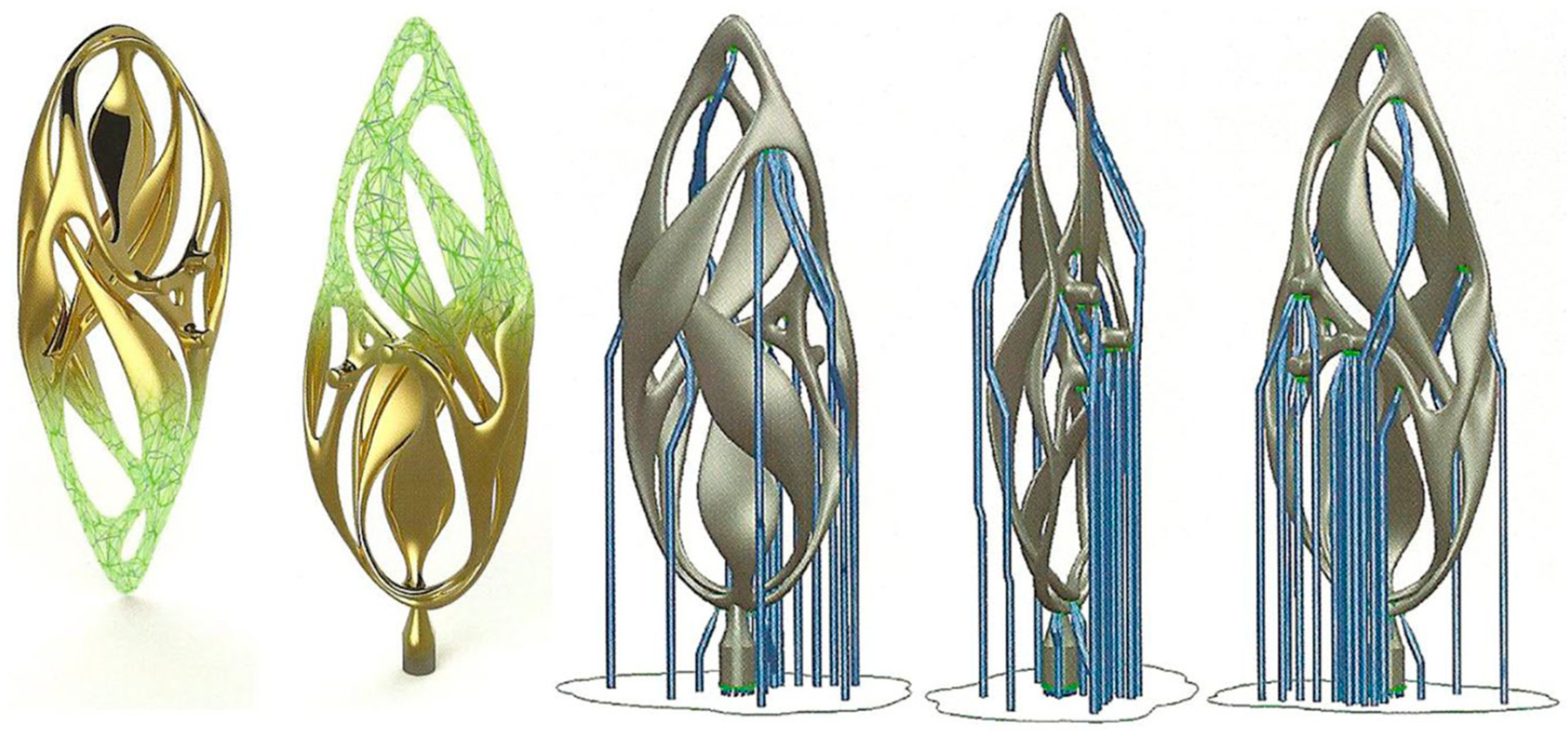
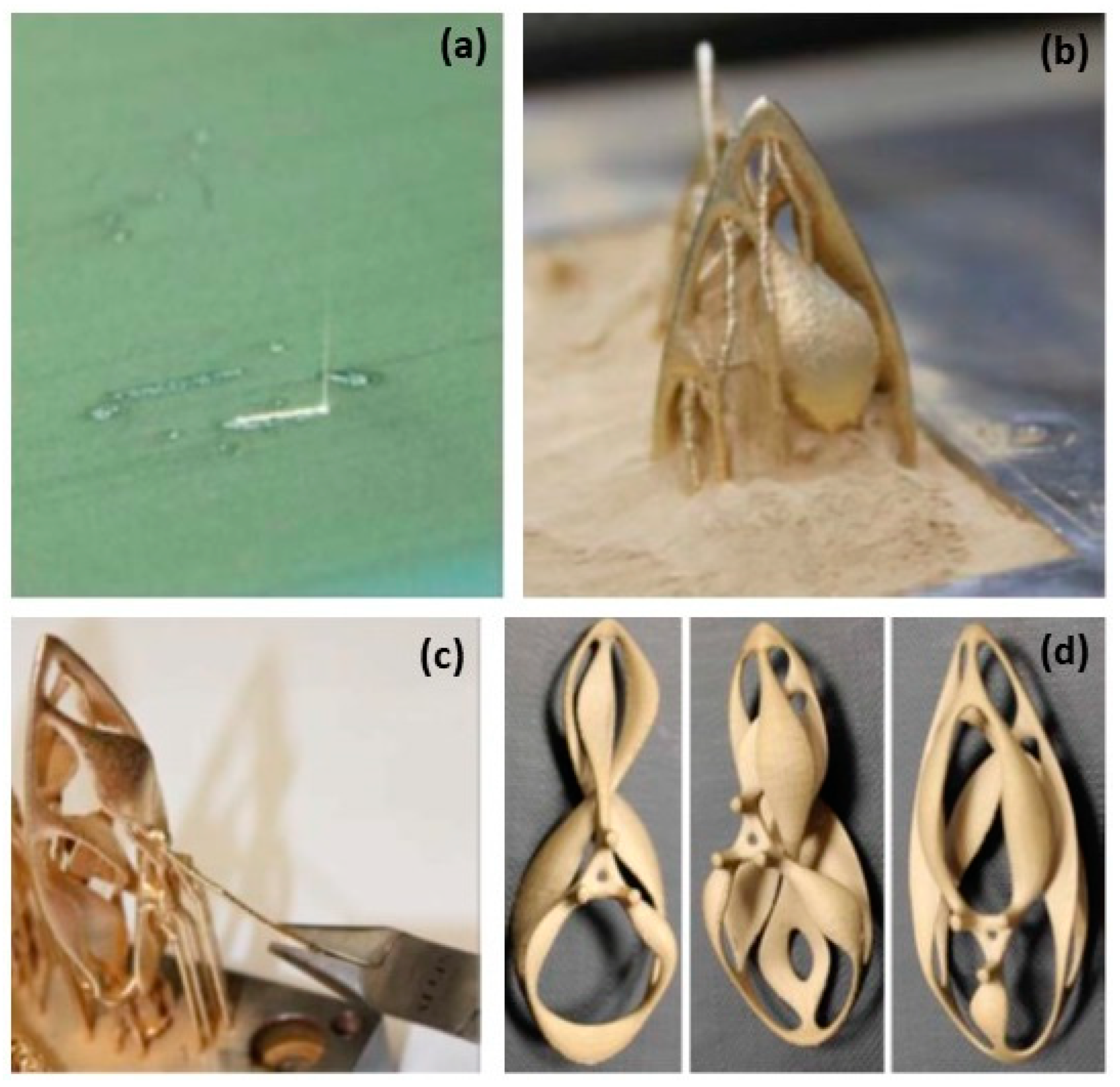
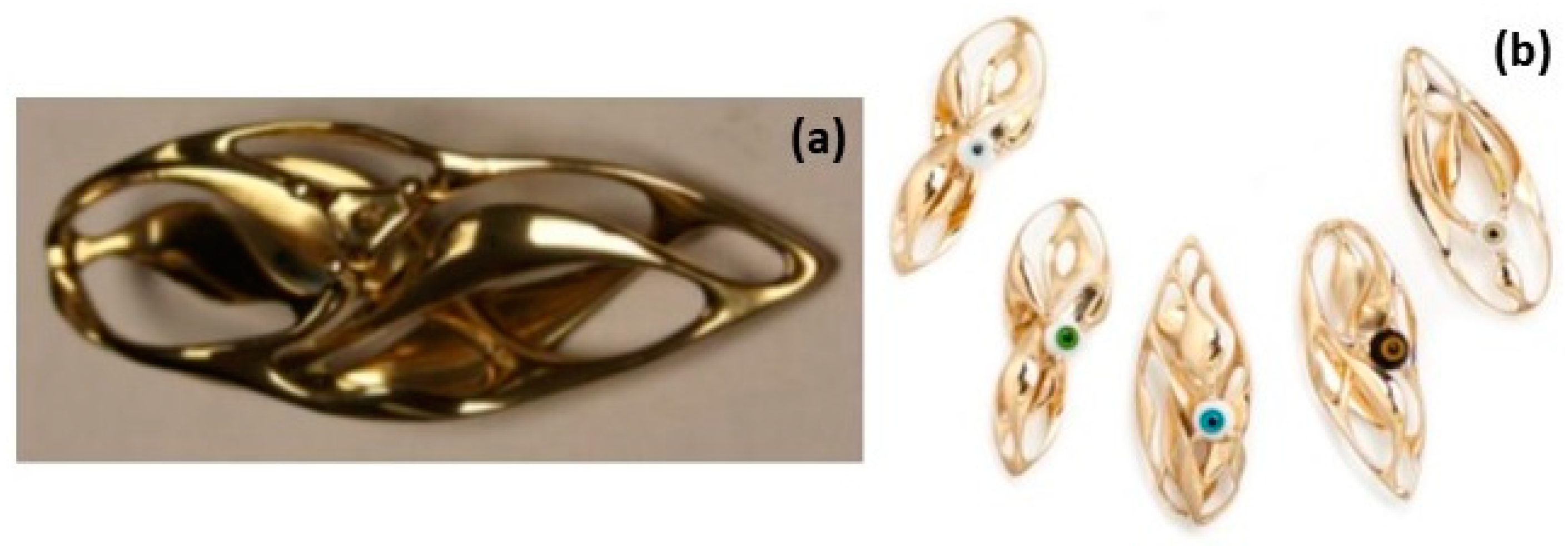
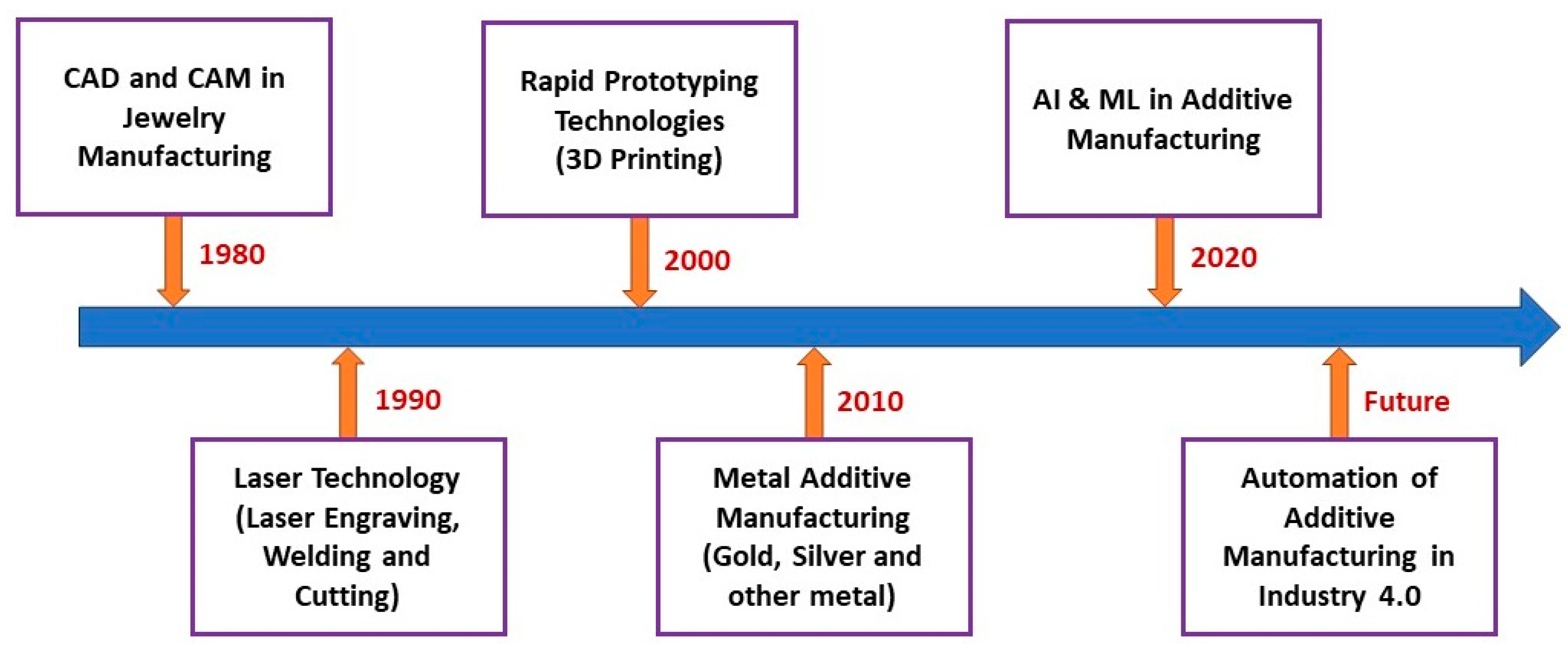

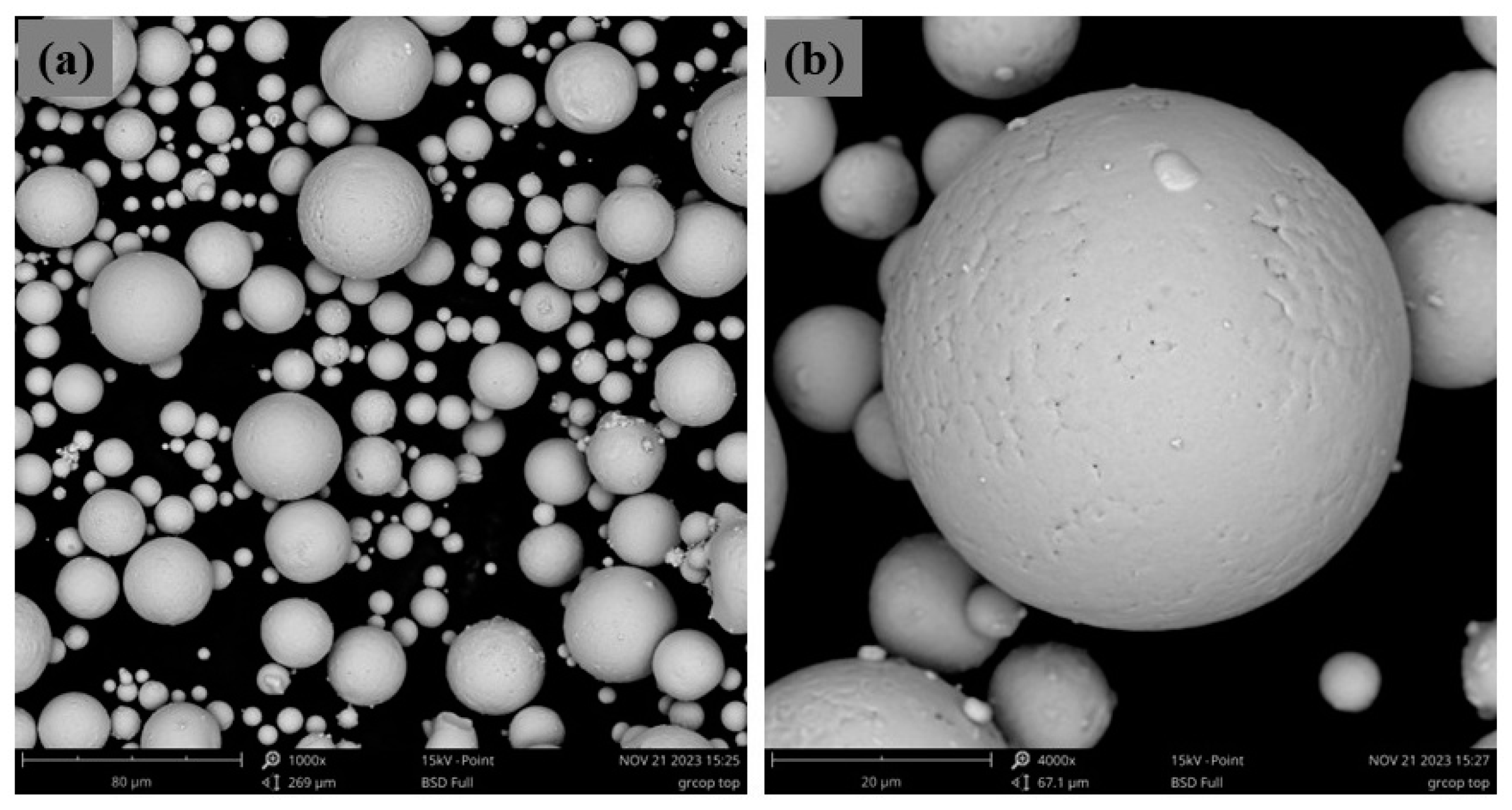
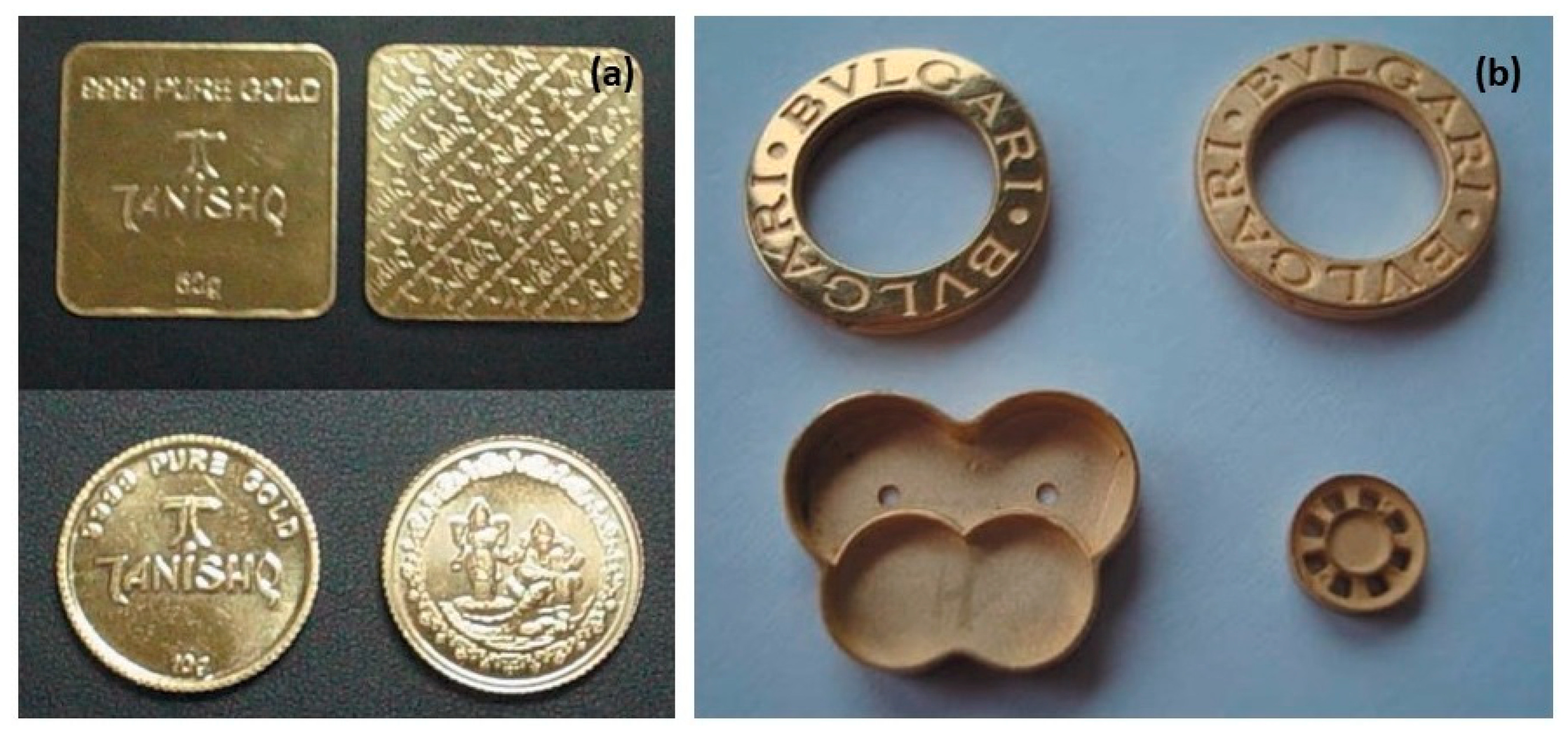

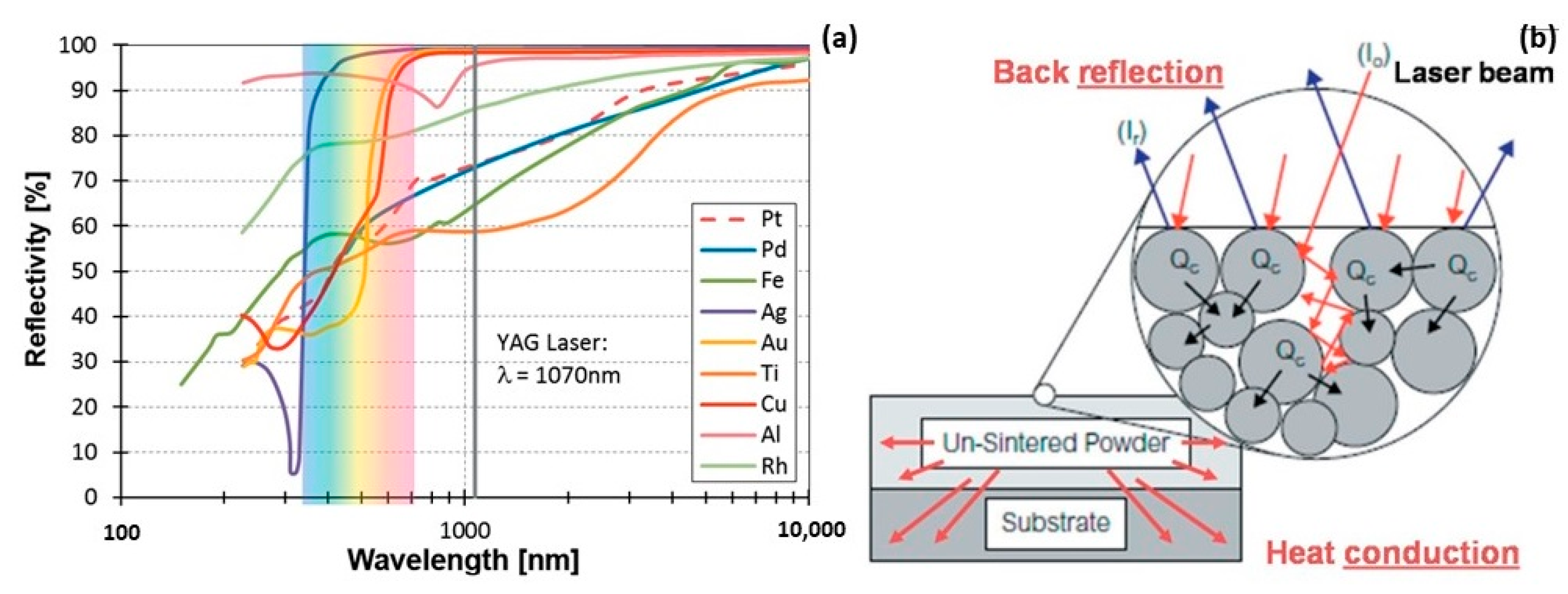



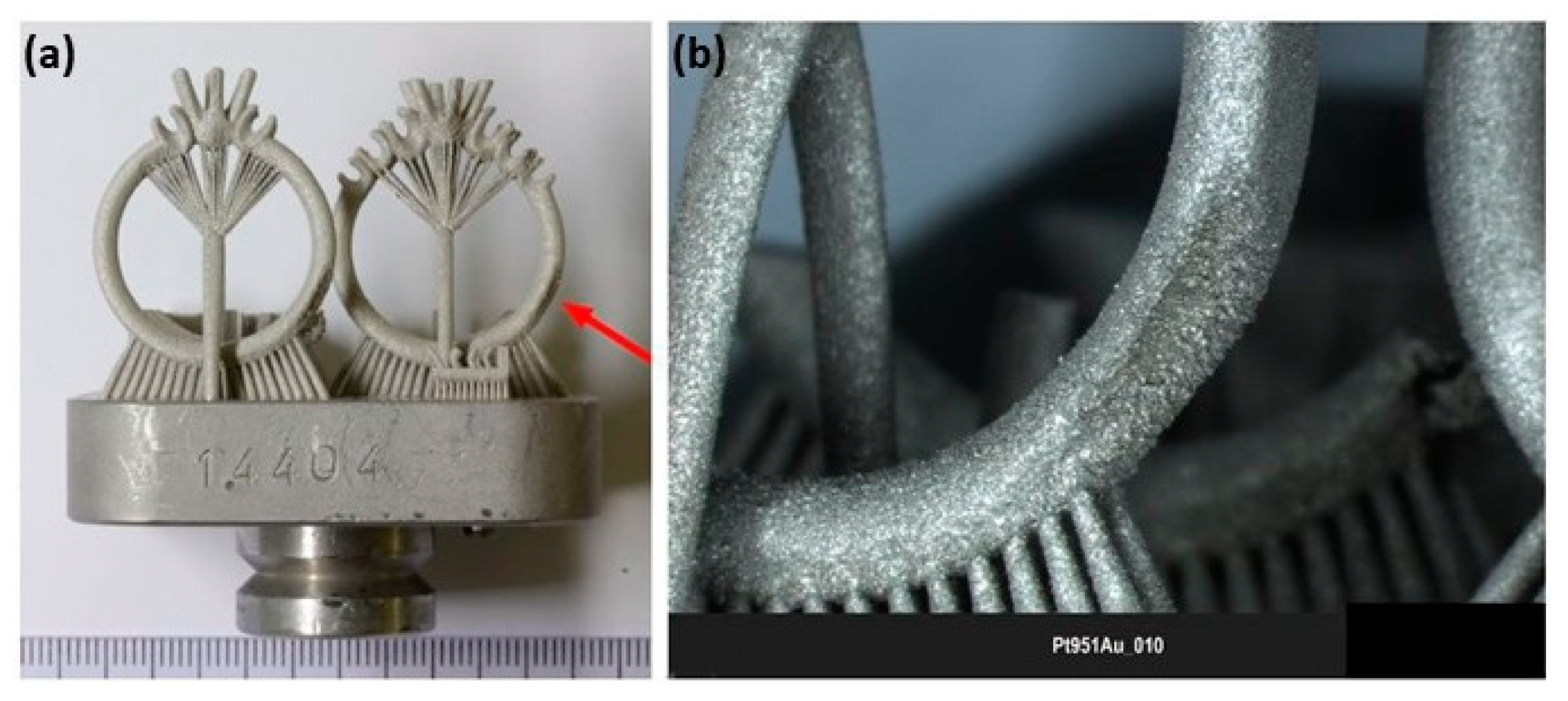


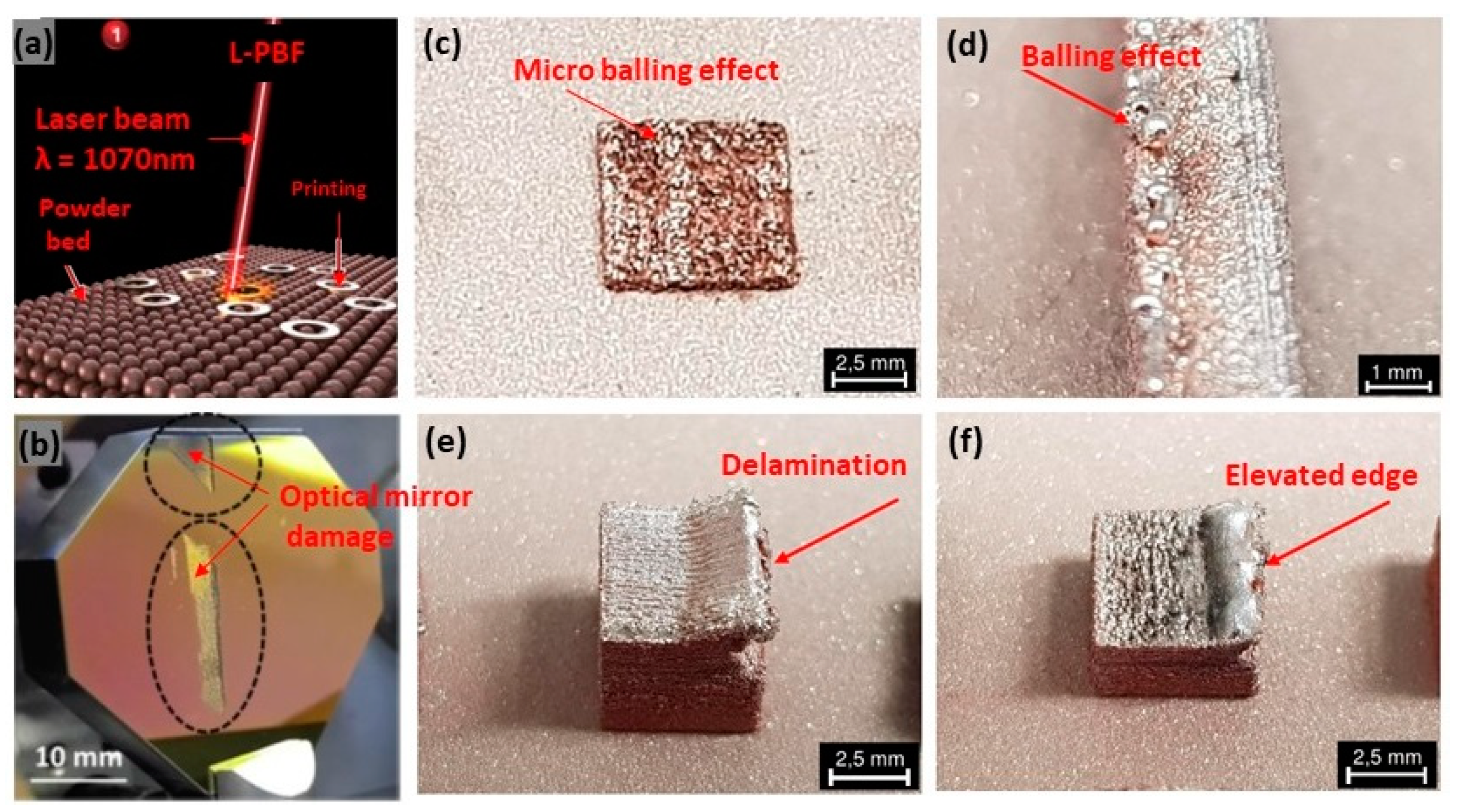

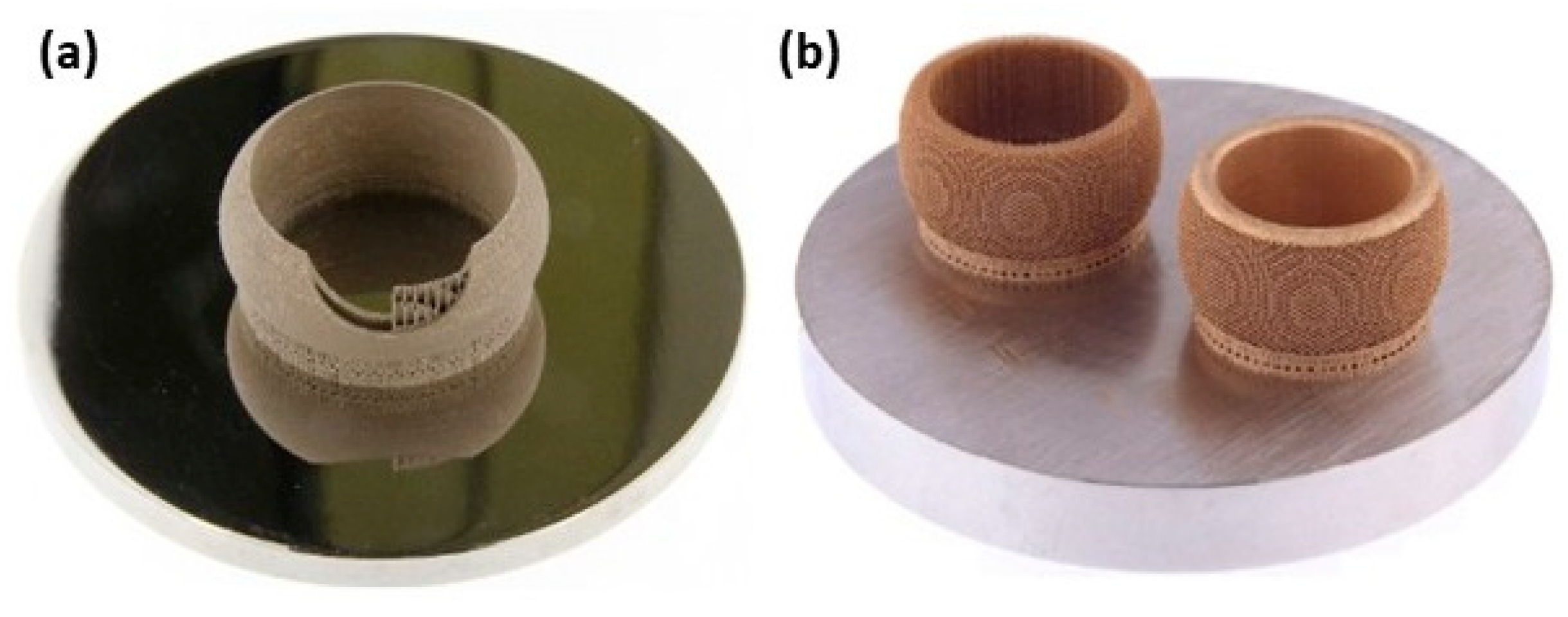
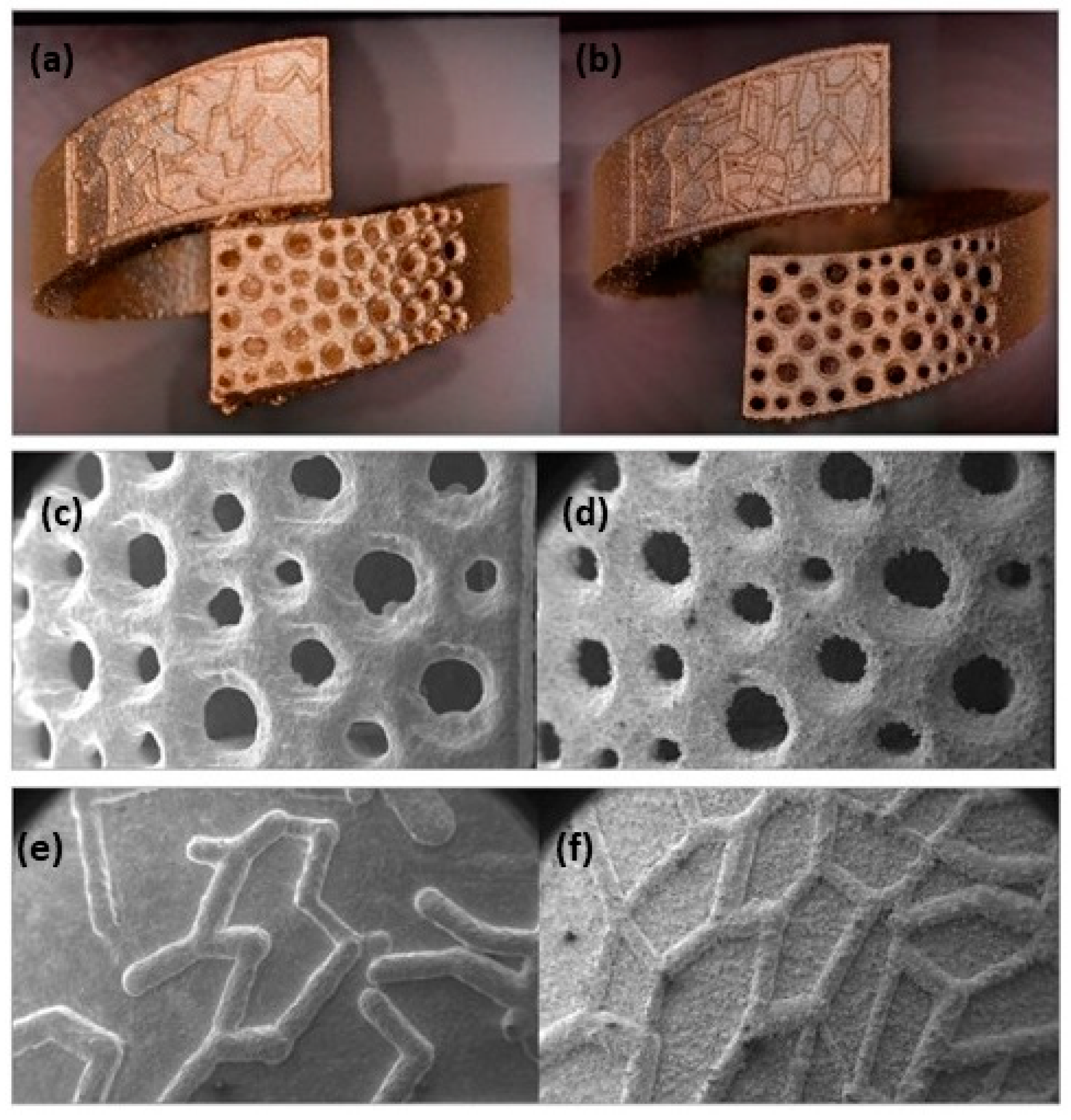
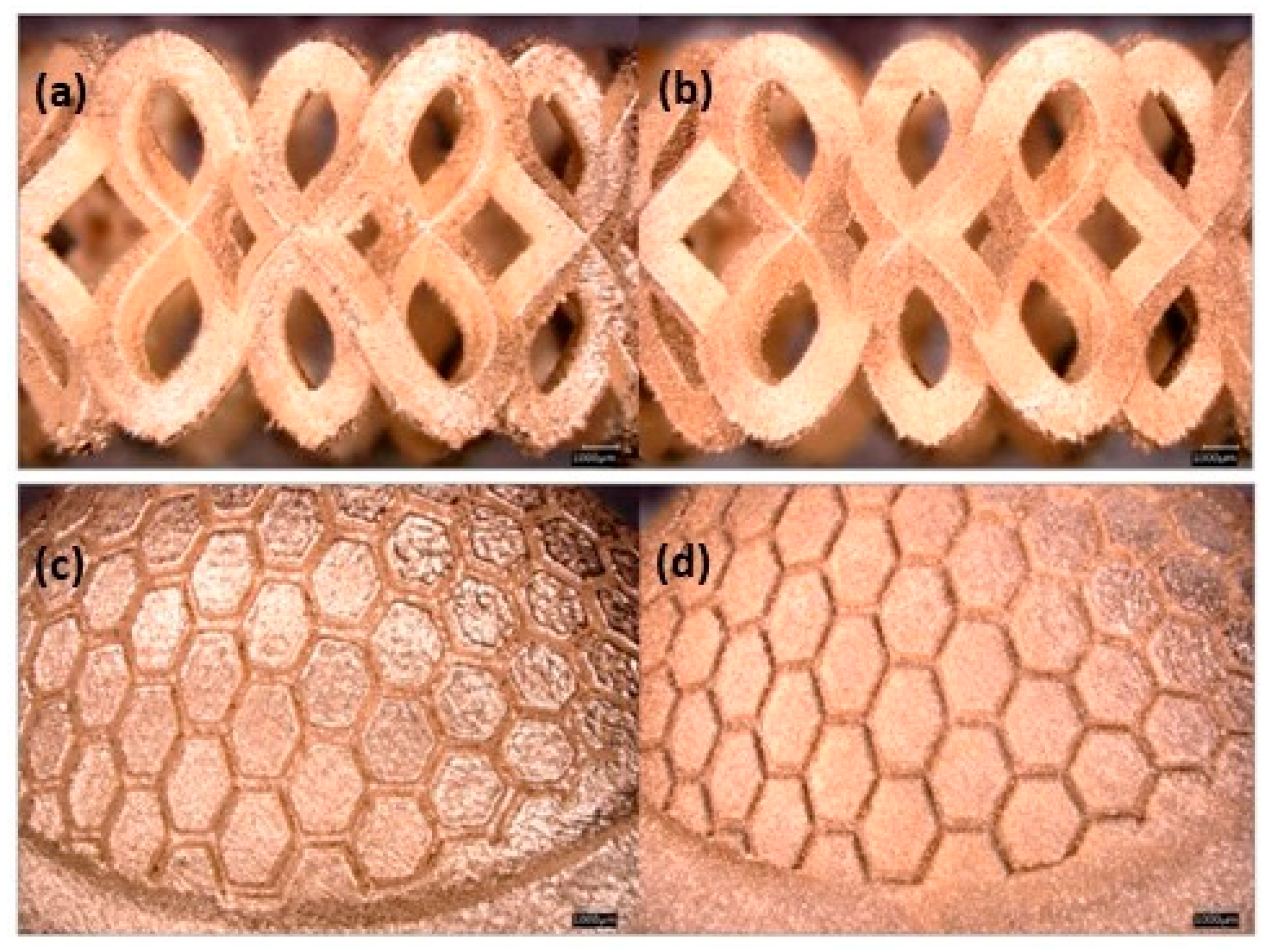
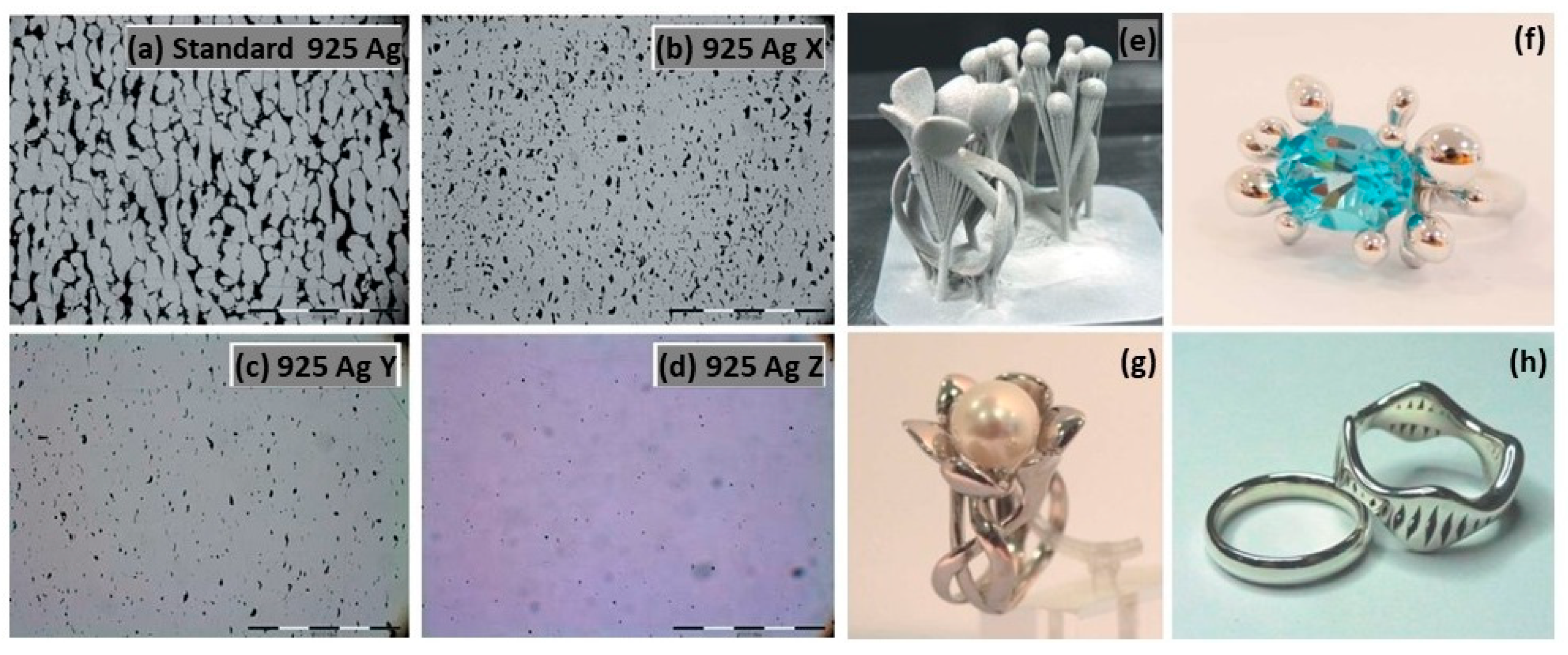
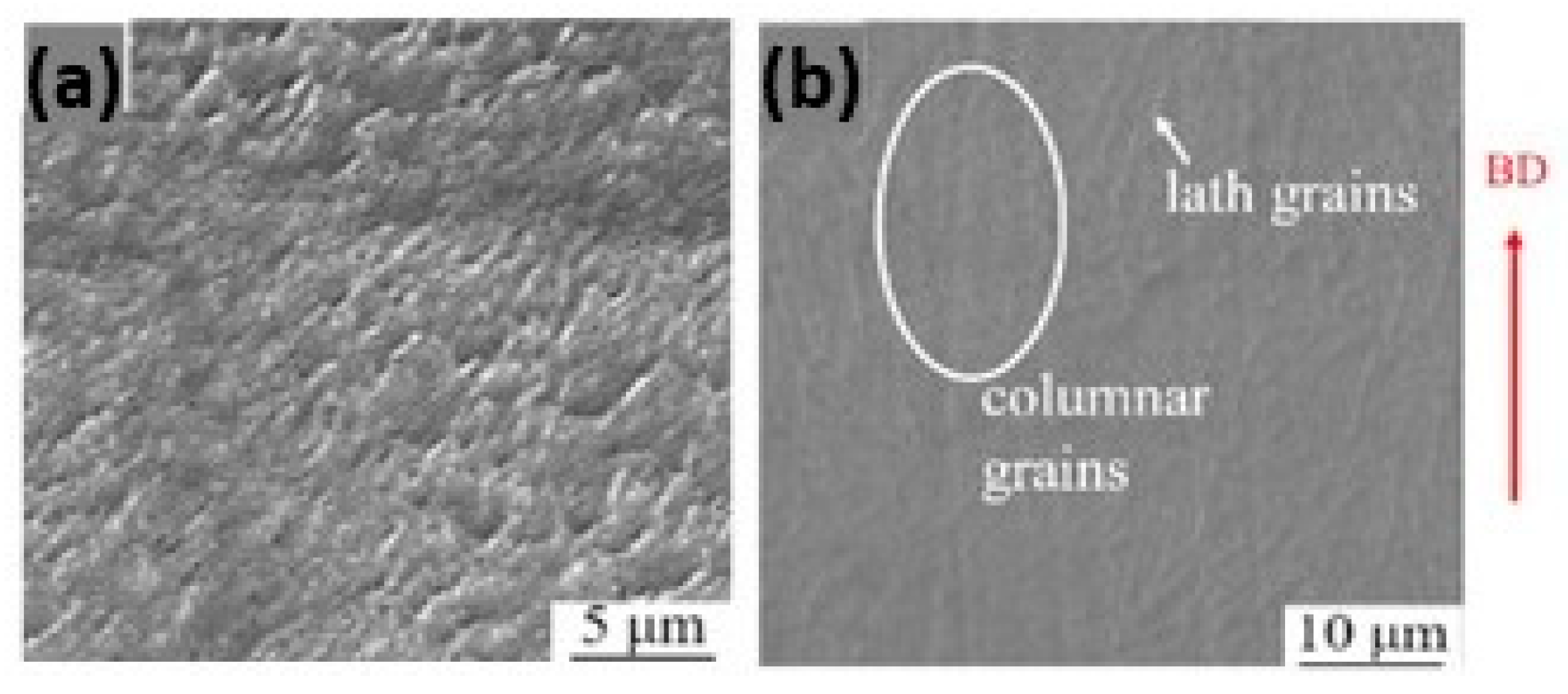
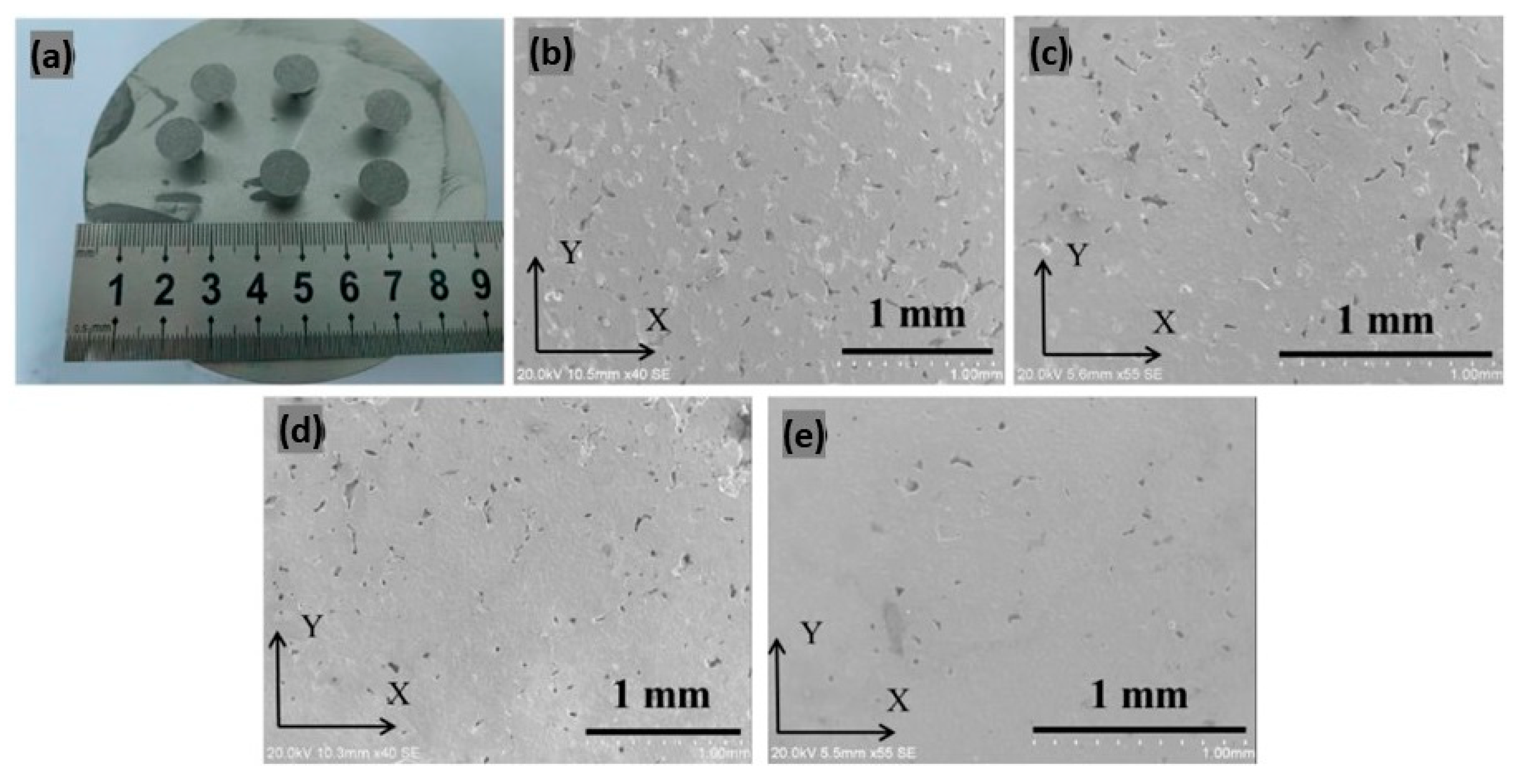
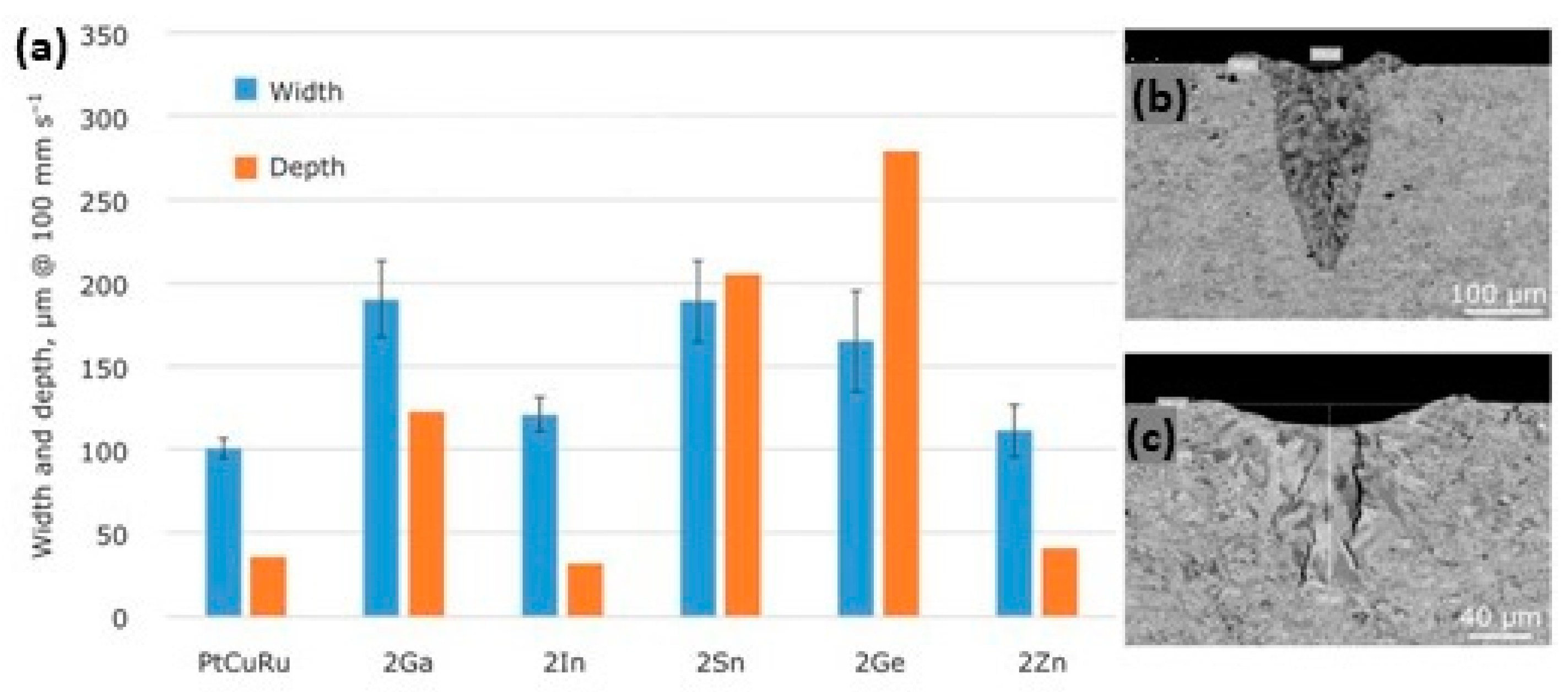

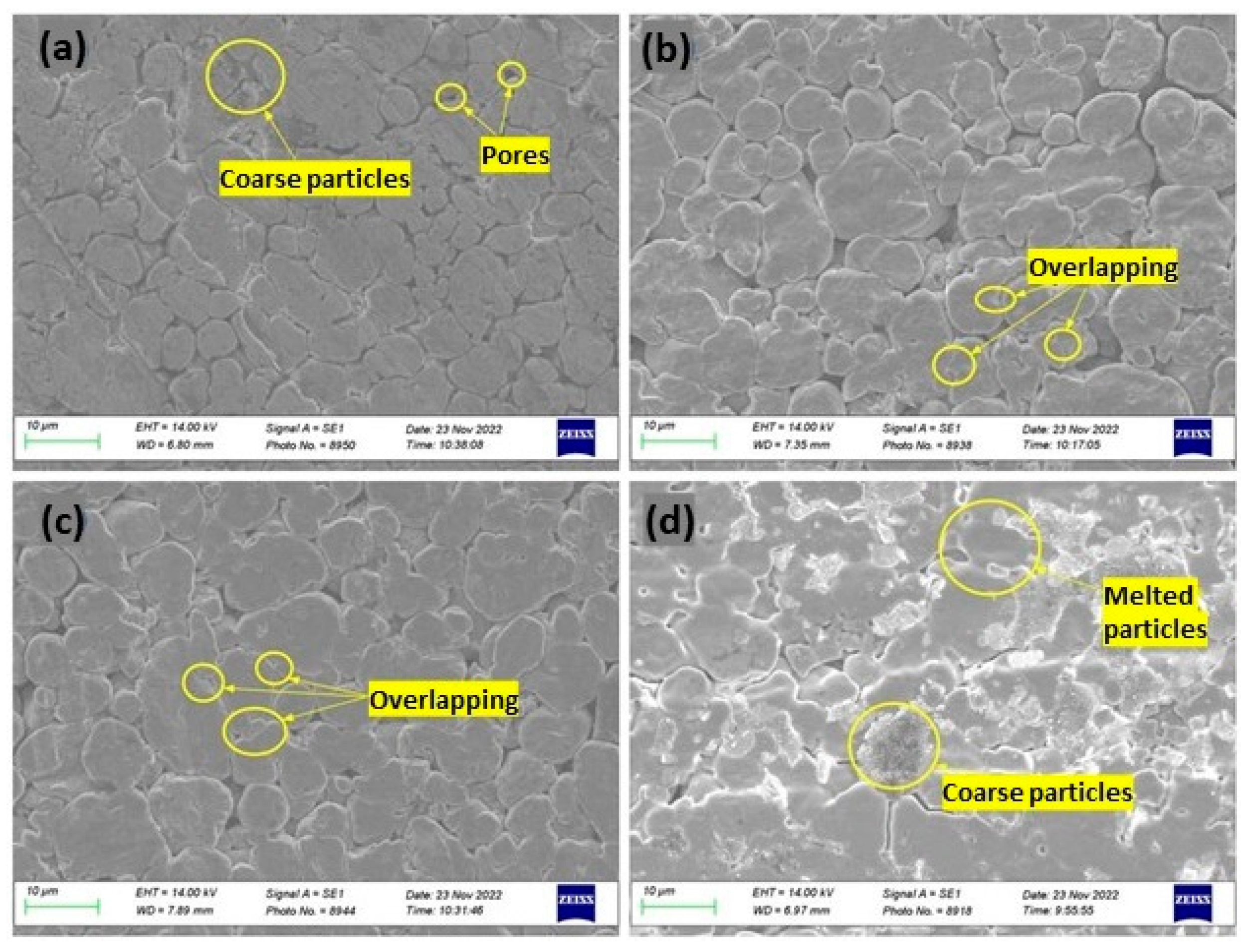




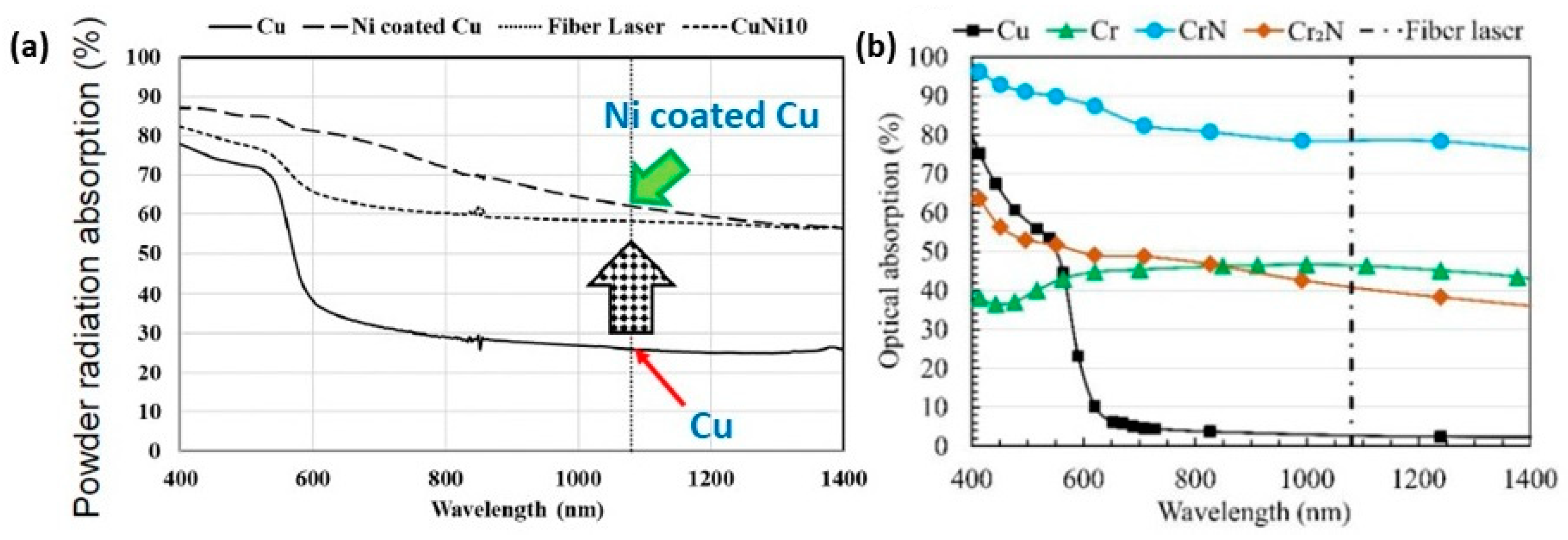
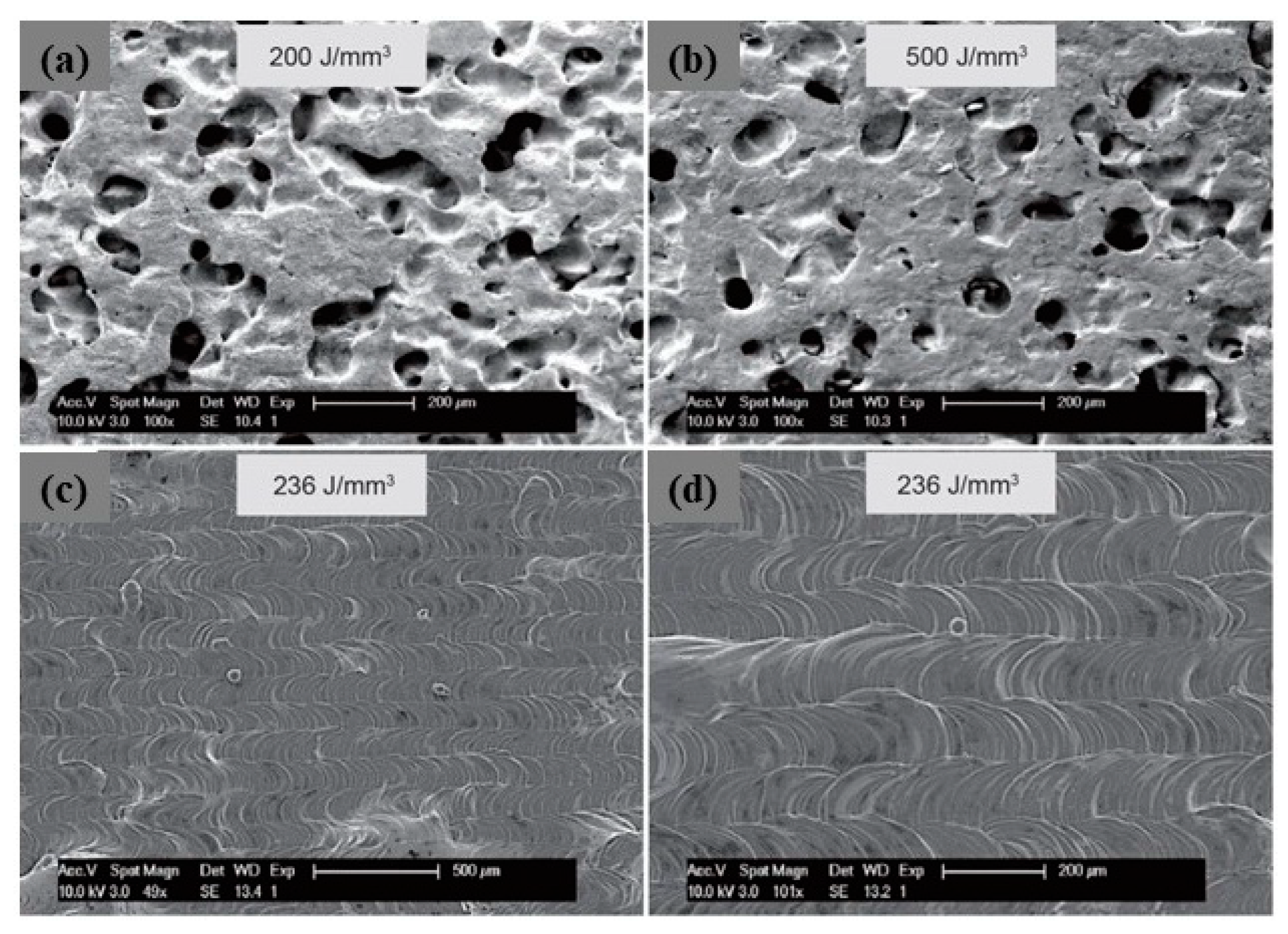
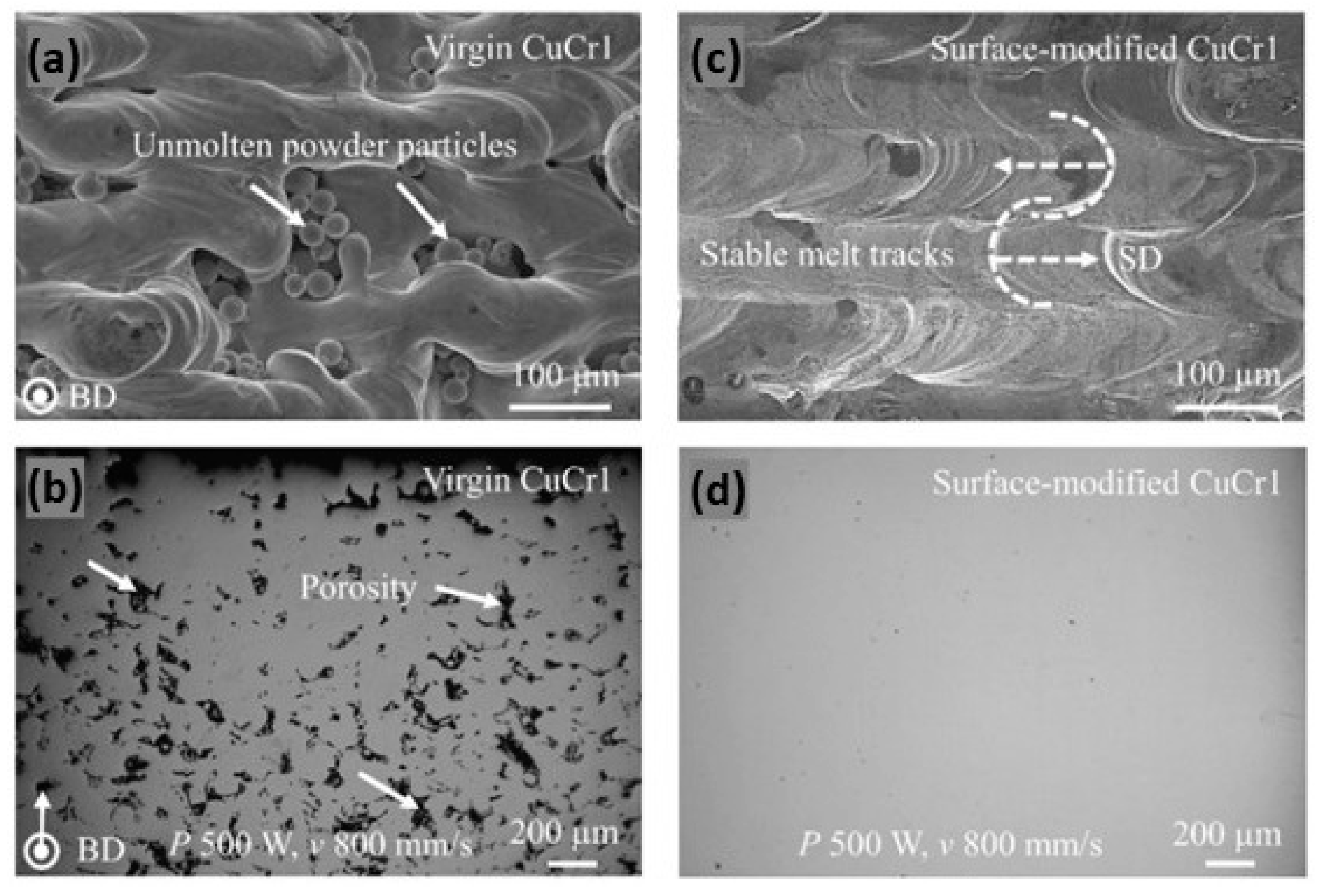
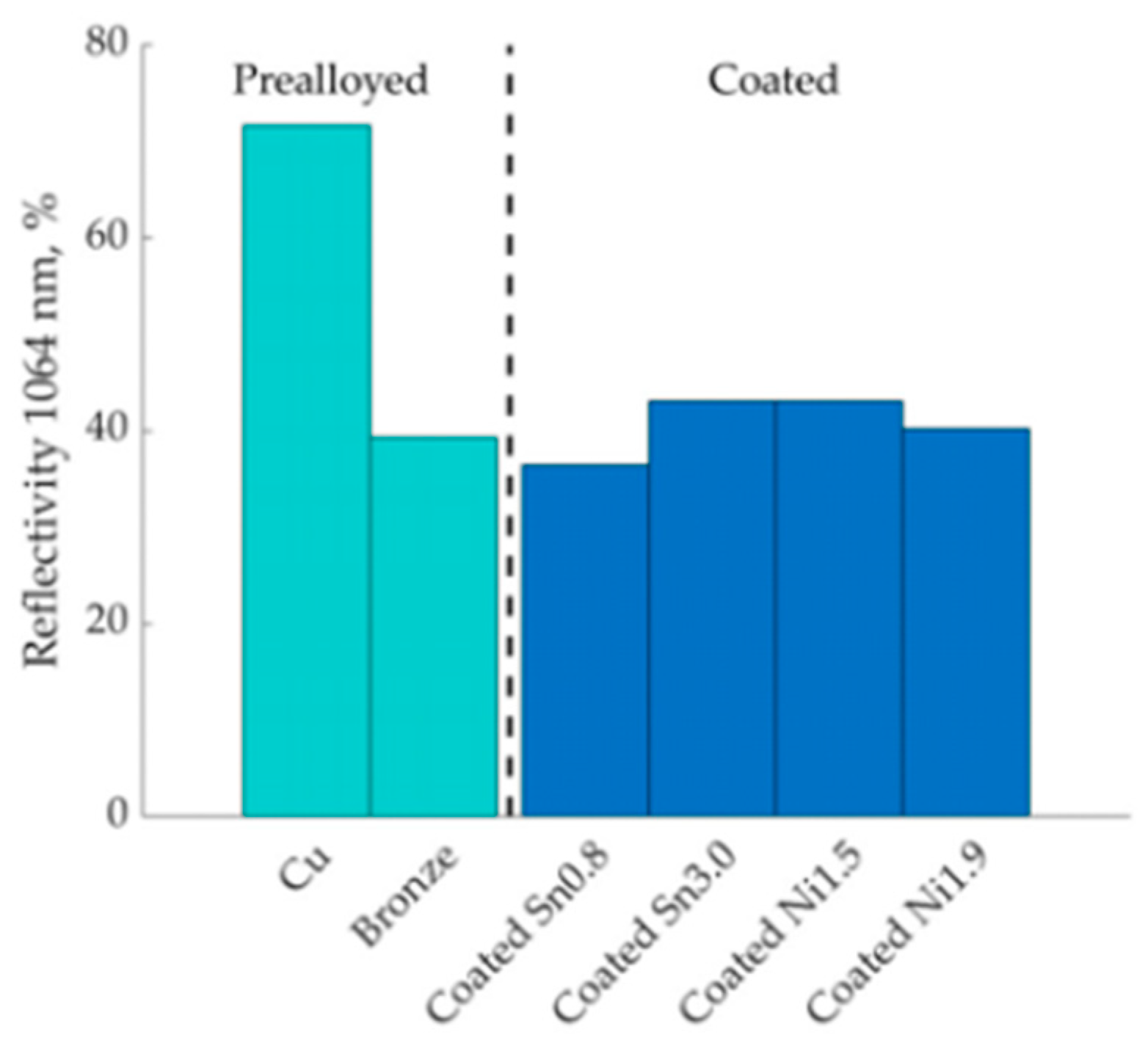
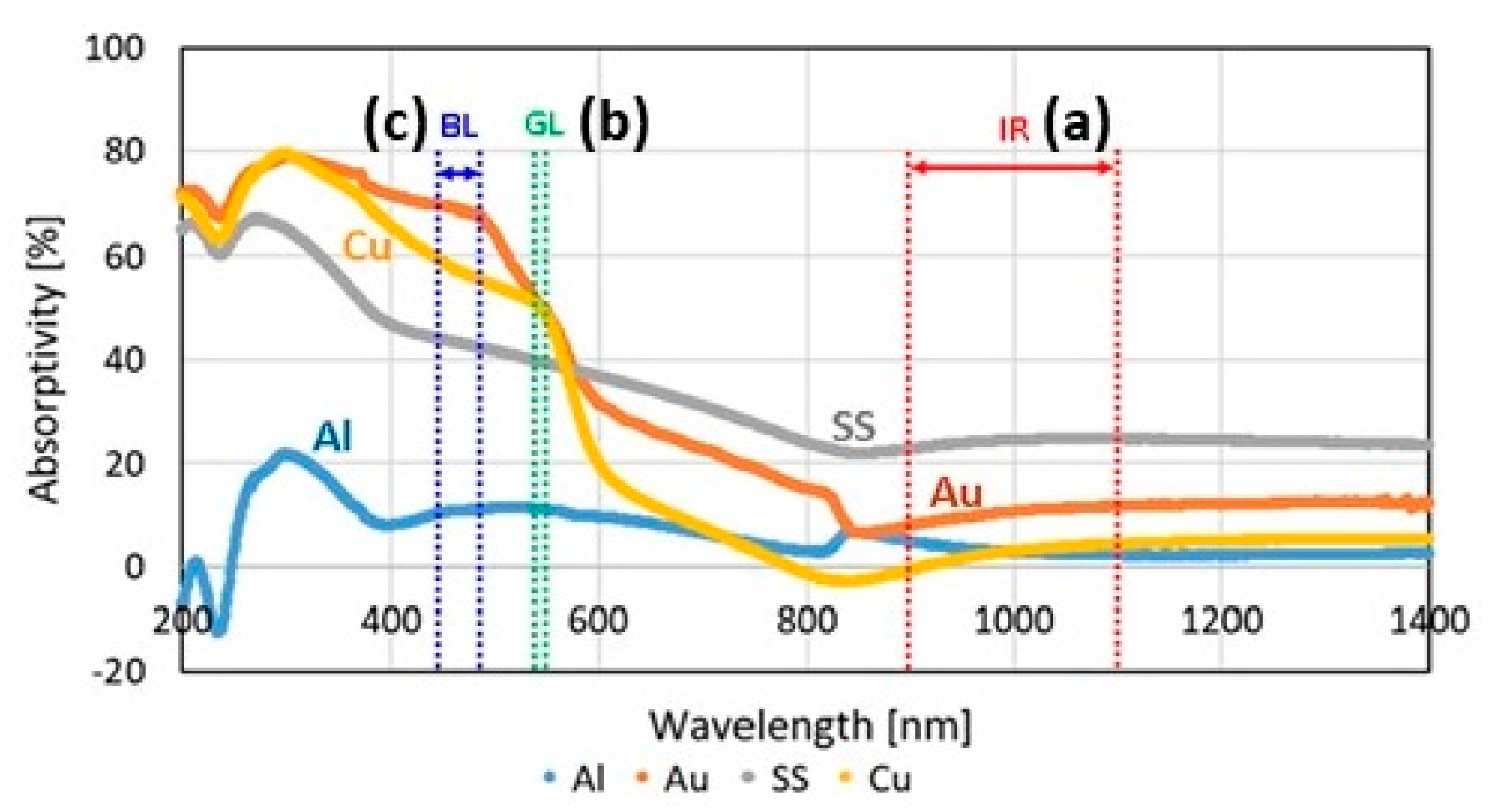

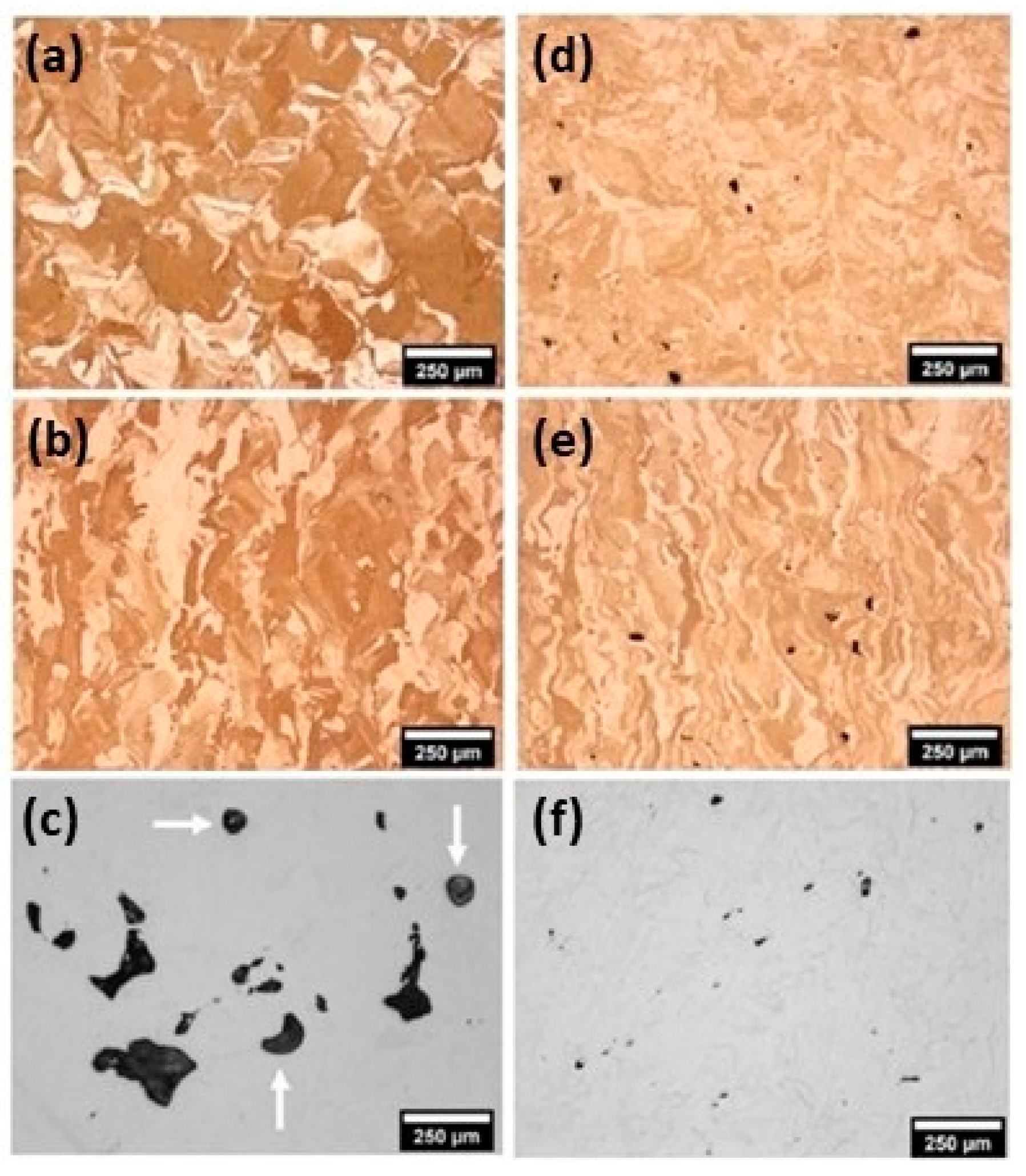
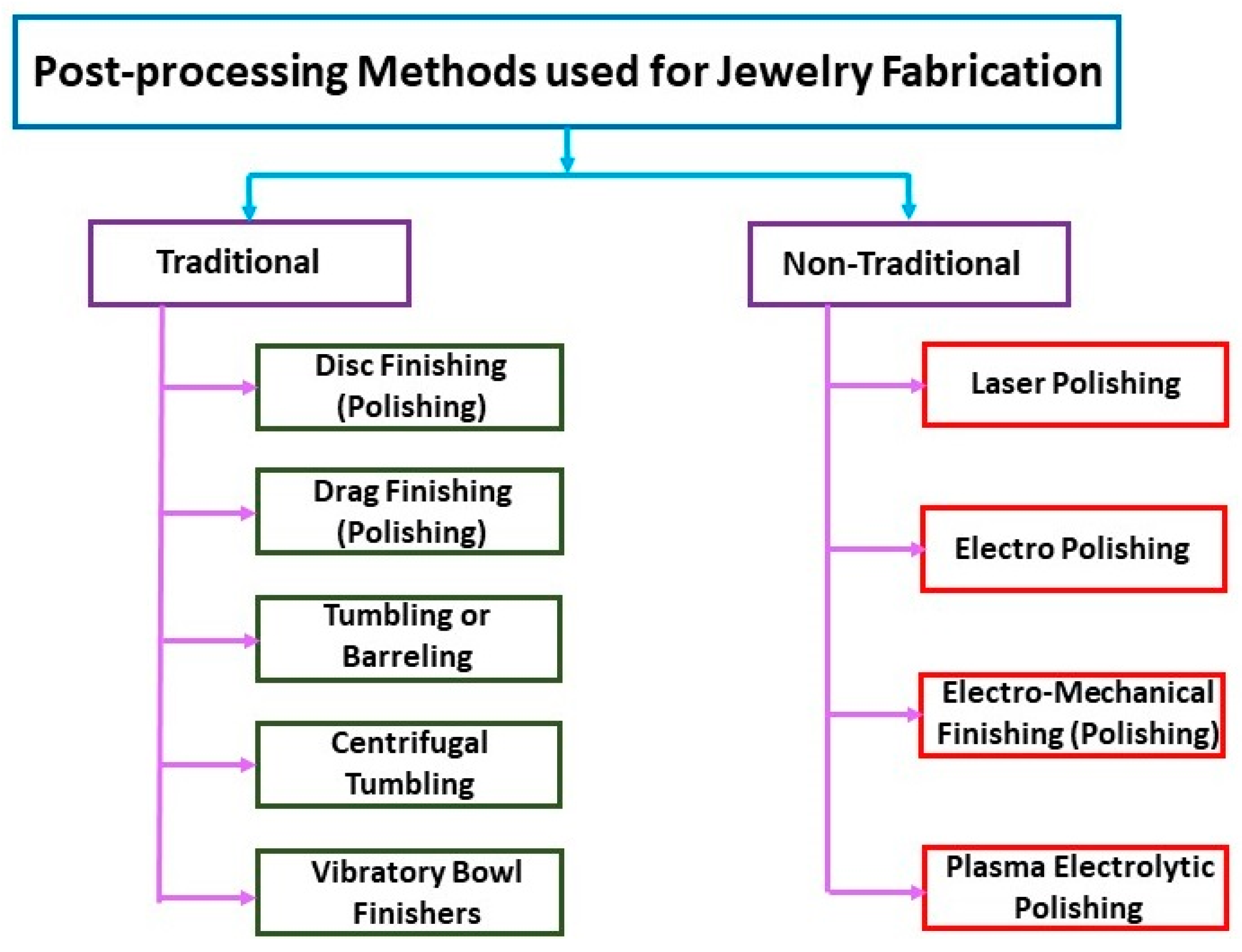
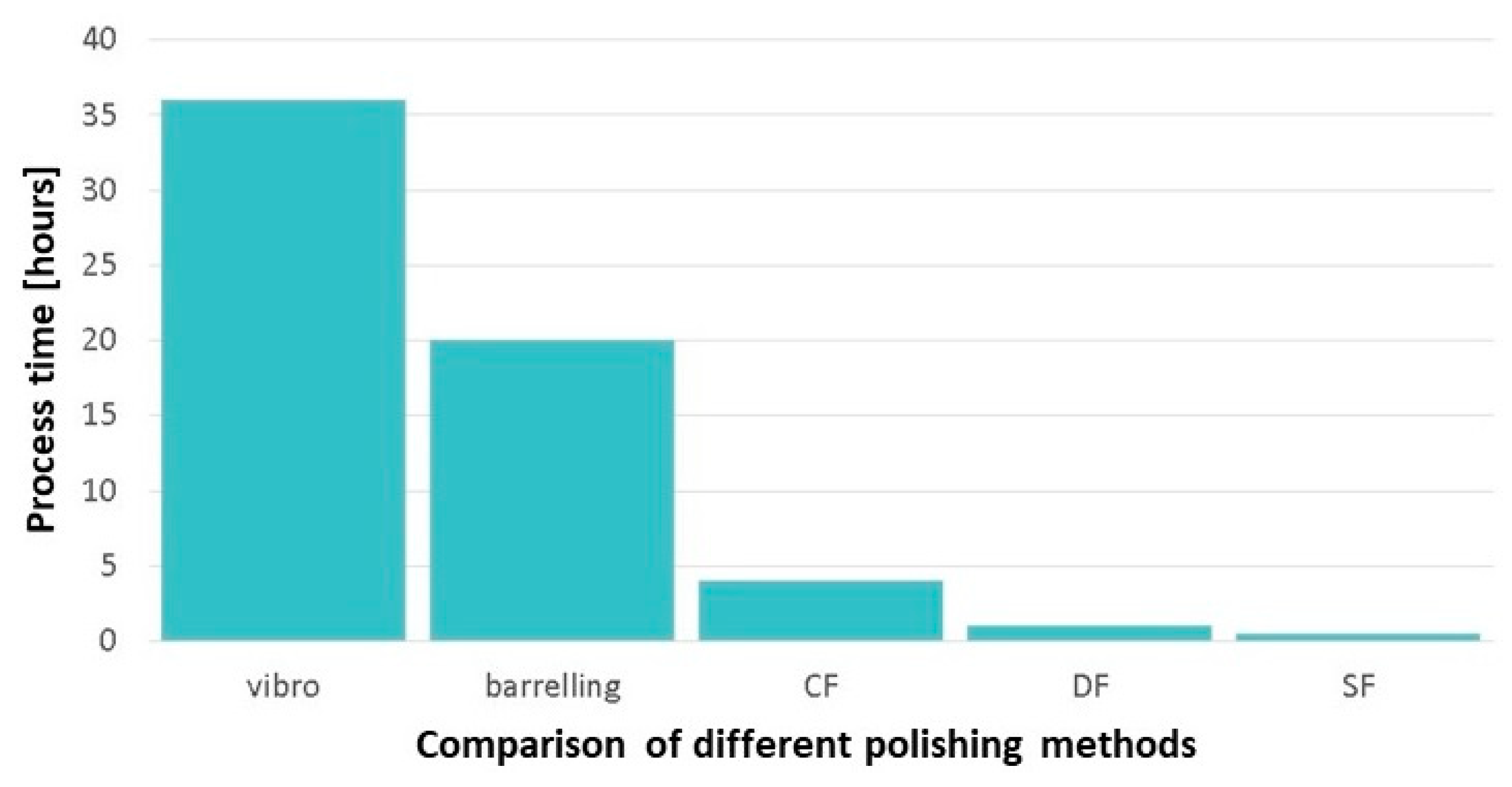


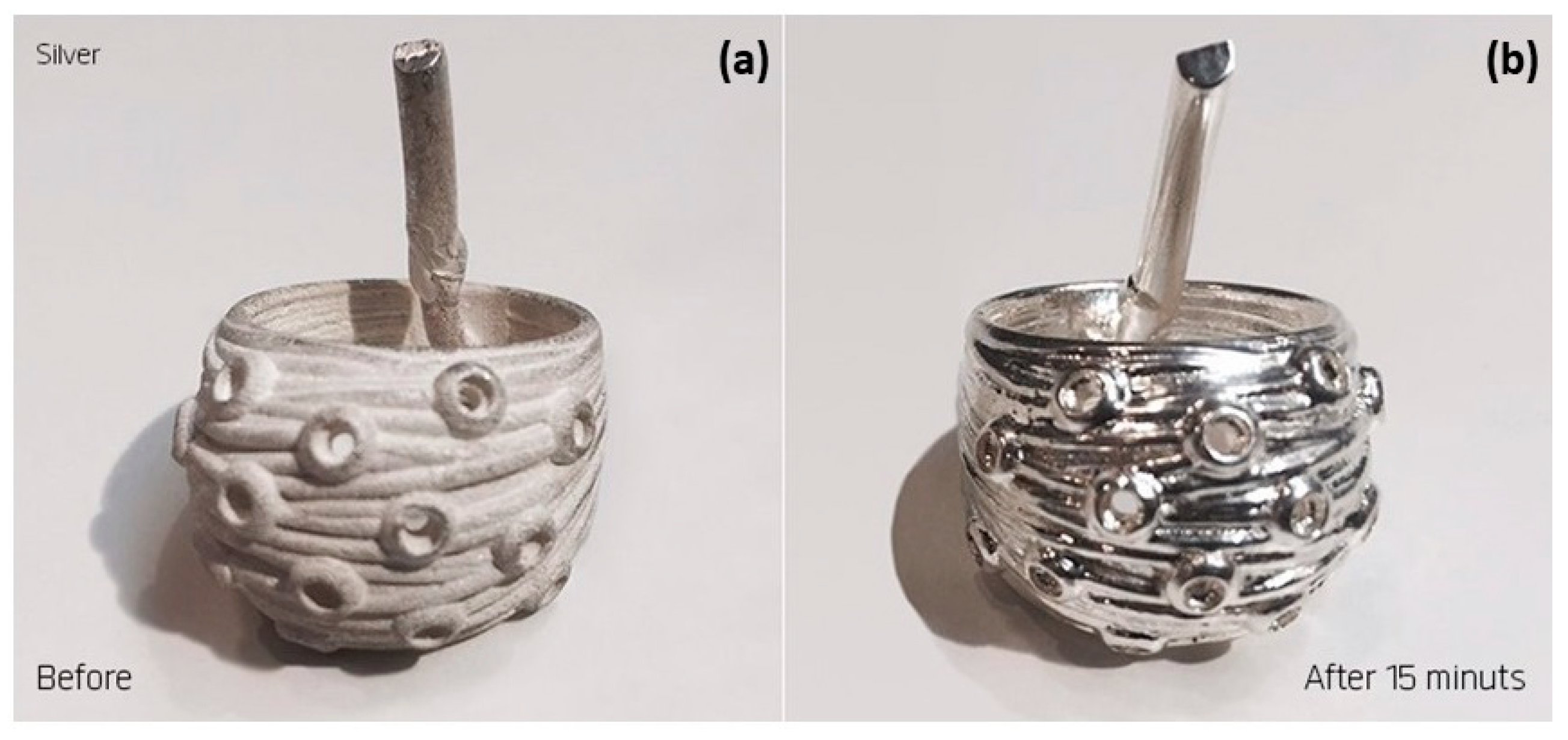
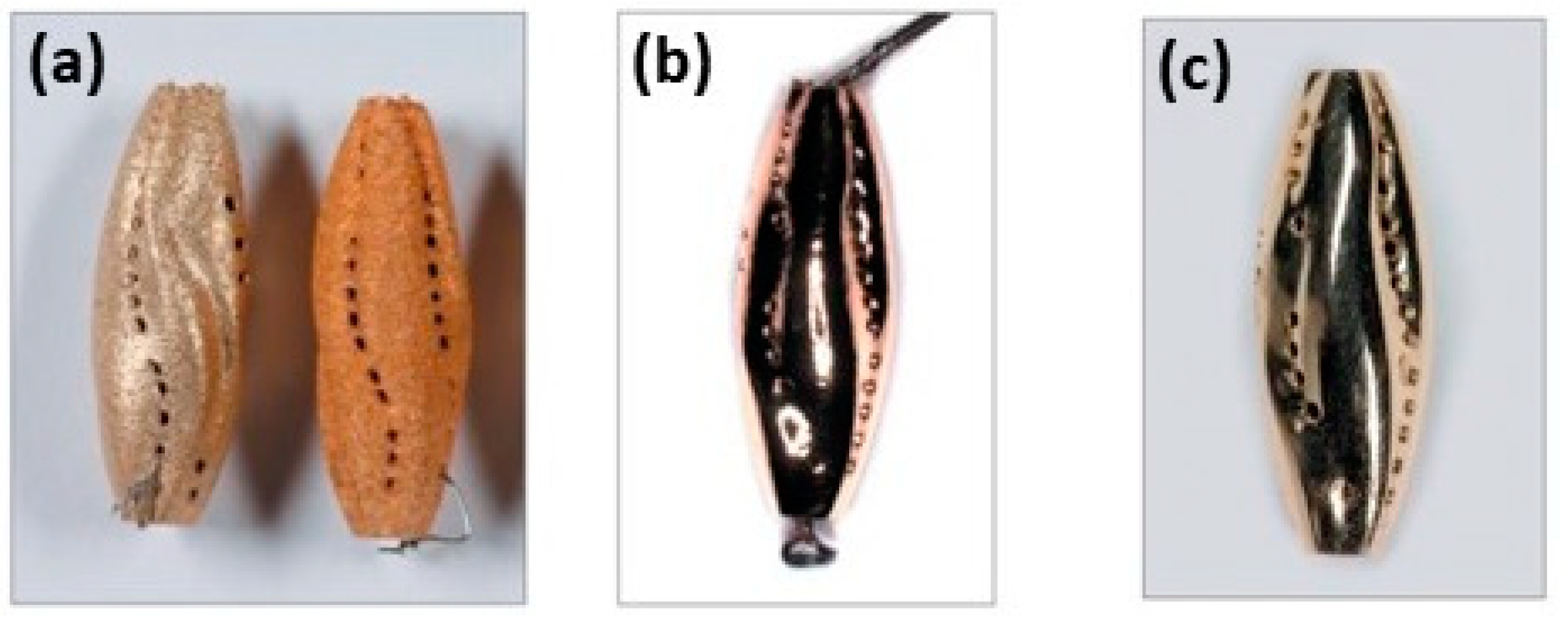


| Materials | Composition/Strategy | Laser Power (W) | Layer Thickness (μm) | Scanning Speed (mm/s) | Hatch Distance (μm) | Relative Density (%) | Porosity (%) | Ref. |
|---|---|---|---|---|---|---|---|---|
| Gold | Yellow-gold alloy (75Au12.5Ag12.5Cu) | 95 | 15–25 | 250–450 | - | - | ±0.2 | [23] |
| 24-carat gold | 50 | 100 | 65 | 80 | - | <10.4 | [24] | |
| 750% yellow-gold alloy | 65 | 30 | 330 | 35 | - | - | [47] | |
| Au, Ag, Ti | 50 | - | 250 | 150 | - | 0.22 ± 0.04 | [48] | |
| 750‰ red-gold alloy addition germanium | 72.5 | 140 | 330 | - | - | <0.5 | [49] | |
| 3N YG + Fe003 | 90 | 15 | 250–450 | 36 | 97 | <0.5 | [51] | |
| 3N YG + Ge001 | 90 | 15 | 250–450 | 36 | 99.7 | <0.3 | [51] | |
| Fe003 + Ge001 | 90 | 15 | 250–450 | 36 | 99.9 | <0.2 | [51] | |
| Gold alloy: Table 2 | 72.5 | 140 | 330 | - | - | <0.5 | [53] | |
| Ag–Cu alloys with La2O3 of 0% | 600 | 20 | 1000 | - | 84.7 | - | [55] | |
| Ag–Cu alloys with La2O3 of 0.4% | 600 | 20 | 1000 | - | 88.8 | - | [55] | |
| Ag–Cu alloys with La2O3 of 0.8% | 600 | 20 | 1000 | - | 93.3 | - | [55] | |
| Ag–Cu alloys with La2O3 of 1.2% | 600 | 20 | 1000 | - | 99.9 | - | [55] | |
| Gold alloy | 72.5 | 140 | 330 | - | - | 0.01 | [65] | |
| Silver | 99.9% Pure silver | 370 | 30 | 550–800 | 150 | 97 | 2.72–34.01 | [27] |
| Silver | 350–370 | 30 and 60 | 400–500 | 150 | 97 | ±3 | [28] | |
| 99.9% Pure silver | 400 | 30 | 400 and 800 | 150 | 99.8 | - | [29] | |
| 99.9% Pure silver | 430 | 30 | 400 | 80 | 91.06 | - | [30] | |
| 925 silver | 180 | 30 | 600 | 60 | 96.56 | - | [30] | |
| Ag7.5Cu alloy | 120 | 30 | 400 | - | 96.7 | - | [54] | |
| Pure Silver (>99%) | 370 | 30 | 400 | 140 | 89.9 | - | [67] | |
| Uncoated silver powder | 320 | - | 500 | - | - | 3.9 | [75] | |
| Titanium (Ti) Coated silver powder | 320 | - | 500 | - | - | 0.2 | [75] | |
| Platinum | Pure Platinum (Pt) | 175 | 30 | 600 | 80 | 99.98 | 0.01 | [31] |
| 950Pt alloy (950Pt-Ga-Cu) | 95 | 20 | 500 | 63 | >99.8 | <0.1 | [32] | |
| 950‰ platinum alloy | 62.5 | 140 | 250–330 | - | - | <0.06 | [49] | |
| 950‰ Platinum | 72.5 | 140 | 250–330 | - | - | [50] | ||
| 95PtGaInCu alloy | 72.5–80 | 20 | 250–330 | - | - | 0.06 | [57] | |
| 950Pt with Au, In and Ru | 90 | 15 | - | - | 99.97 | - | [60] | |
| 80Pt20Ir | 90 | 20 | - | - | 99.97 | - | [60] | |
| 50Pd50Rh | 90 | 20–50 | - | - | 99.8 | - | [60] | |
| 50Pt50Rh | 90 | 20–50 | - | - | 98.5 | - | [60] | |
| Copper | Pure copper 99.9% | 350–1000 | 30–50 | 400–600 | 80 | >99 | - | [34] |
| Pure copper powder 99.9Cu0.08O0.15P | 600–1000 | 50 | 1000–5500 | 70 | 99.1 | - | [35] | |
| Electrolytic Tough Pitch copper > 99.90% | 400–500 | 30 | 400–600 | - | 99.82 | - | [36] | |
| Pure copper | 600–800 | 30 | 200–400 | 70–90 | 98 | - | [38] | |
| Pure copper | 300–800 | 30–50 | 200–1500 | 20–120 | 99.1 | - | [39] | |
| Copper (Cu) | 400 | 30 | 600 | 100 | 99.82 | - | [40] | |
| 99.8 wt% Cu | 175 | 20 | - | - | 98.1 | - | [41] | |
| Pure copper (Cu) | 500 | 30 | 800 | 90 | 99.3 ± 0.2 | - | [42] | |
| Pure copper (Cu) | 370 | 30 | 1000 | 100 | 99.5 | - | [43] | |
| Virgin CuCr0.3 | 600 | 30 | 300 and 400 | 90 | 98.5 | - | [64] | |
| Carbon-mixed CuCr0.3: 0.05% Carbon | 600 | 30 | 300 and 400 | 90 | 98.5 | - | [64] | |
| Carburized CuCr1 powder | 500 | 30 | 700 | 90 | 99.2 | - | [66] | |
| Heat treated | 500 | 30 | 700 | 90 | 99.3 | - | [66] | |
| Pure Copper (>99%) | 370 | 30 | 400 | 140 | 99.9 | - | [67] | |
| CuAg10: 92.51% Cu, 7.49% Ag | 370 | 30 | 400 | 140 | 100 | - | [67] | |
| CuAg20: 72.50% Cu, 27.50% Ag | 370 | 30 | 400 | 140 | 100 | - | [67] | |
| CuAg30: 64.20% Cu, 35.80% Ag | 370 | 30 | 400 | 140 | 100 | - | [67] | |
| CuAg10: 92.51% Cu, 7.49% Ag | 400 | 30 | 400 | 140 | 87 | - | [68] | |
| CuAg20: 72.50% Cu, 27.50% Ag | 400 | 30 | 400 | 140 | 83 | - | [68] | |
| CuAg30: 64.20% Cu, 35.80% Ag | 400 | 30 | 400 | 140 | 99 | - | [68] | |
| Coated materials: Sn, Ni, and CrZr, etc. | 300 | 30 | 800 | 100 | >99 | - | [76] | |
| IR laser | 425–750 | 30 | 1000 | - | >99 | - | [81] | |
| Green laser | 425–750 | 30 | 1000 | - | >99 | - | [81] | |
| Deoxygenated oxygen-free pure copper (Cu-OF) | 500 | 30 | - | 120 | 99.8 | 0.017 ± 0.024 | [82] | |
| Oxygenated electrolytic tough pitch copper (Cu-ETP) | 500 | 30 | - | 120 | 99.8 | 0.013 ± 0.009 | [82] | |
| IR laser | 500 | 30 | - | - | 99.8 | - | [84] | |
| Green laser | 500 | 30 | - | - | 99.8 | - | [84] | |
| Pure copper (Cu-OFE, C10100) | 500 | 30 | 250–350 | 100 | 99.9 | - | [85] | |
| Blue laser (450 nm) | 650 | - | 1000 | - | 99.6 | - | [88] | |
| Pure copper (99.9 wt%) | 370 | 40 | 500 | 100 | 96 | - | [90] | |
| Pure copper | 500 | 30 | 400 | 90 | 97.5 | - | [91] | |
| Virgin CuCr1 alloy | 500 | 30 | 200 | 90 | 98.64 | - | [92] | |
| Surface-modified CuCr1 alloy | 500 | 30 | 800 | 90 | 99.1 | - | [92] | |
| Pure copper | 500 | 30 | 500 | 90 | 99.6 | - | [93] |
Disclaimer/Publisher’s Note: The statements, opinions and data contained in all publications are solely those of the individual author(s) and contributor(s) and not of MDPI and/or the editor(s). MDPI and/or the editor(s) disclaim responsibility for any injury to people or property resulting from any ideas, methods, instructions or products referred to in the content. |
© 2024 by the authors. Licensee MDPI, Basel, Switzerland. This article is an open access article distributed under the terms and conditions of the Creative Commons Attribution (CC BY) license (https://creativecommons.org/licenses/by/4.0/).
Share and Cite
Thangamani, G.; Felicioni, S.; Padovano, E.; Biamino, S.; Lombardi, M.; Ugues, D.; Fino, P.; Bondioli, F. A Comprehensive Review of Laser Powder Bed Fusion in Jewelry: Technologies, Materials, and Post-Processing with Future Perspective. Metals 2024, 14, 897. https://doi.org/10.3390/met14080897
Thangamani G, Felicioni S, Padovano E, Biamino S, Lombardi M, Ugues D, Fino P, Bondioli F. A Comprehensive Review of Laser Powder Bed Fusion in Jewelry: Technologies, Materials, and Post-Processing with Future Perspective. Metals. 2024; 14(8):897. https://doi.org/10.3390/met14080897
Chicago/Turabian StyleThangamani, Geethapriyan, Stefano Felicioni, Elisa Padovano, Sara Biamino, Mariangela Lombardi, Daniele Ugues, Paolo Fino, and Federica Bondioli. 2024. "A Comprehensive Review of Laser Powder Bed Fusion in Jewelry: Technologies, Materials, and Post-Processing with Future Perspective" Metals 14, no. 8: 897. https://doi.org/10.3390/met14080897
APA StyleThangamani, G., Felicioni, S., Padovano, E., Biamino, S., Lombardi, M., Ugues, D., Fino, P., & Bondioli, F. (2024). A Comprehensive Review of Laser Powder Bed Fusion in Jewelry: Technologies, Materials, and Post-Processing with Future Perspective. Metals, 14(8), 897. https://doi.org/10.3390/met14080897











